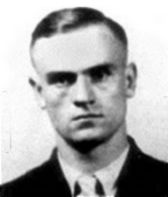

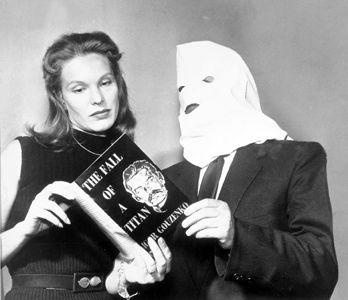
|
|
|



|
Photo credits (in order): www.historyofrights.com - www.csis-scrs.gc.ca - www.thecanadianencyclopedia.com
Igor Gouzenko was born on January 26th, 1919, in Rogochov, USSR.
In 1943, Igor Gouzenko came to Ottawa as a codeclerk in the Soviet Embassy under the supervision of Colonel Zabotin. He and his wife found a home in apartment #4 at 511 Somerset Street West. On the night of 5 September 1945, Igor Gouzenko had made the decision to defect to Canada while bringing with him more than 100 documents as proof that the Soviets were actively spying on Canadians and Americans. The USSR had been WW-II allies with both these countries. Igor Gouzenko did so with his pregnant wife and 2 year old son in tow. Although initially most of the Canadian authorities (Ottawa Police, Ottawa Journal, Justice Minister Louis St-Laurent's office, Mackenzie King's office) he visits turn him down either thinking he is exaggerating, drunk or just trying to stir up trouble, he is eventually found credible by the Solicitor General's secretary Fernande Coulson and, following an interview which she facilitates with Inspector Leopold of the "Anti-Subversive Division" of the RCMP, is eventually given protective custody by the RCMP - thus began the Cold War.
There are many websites devoted to historical details regarding Igor Gouzenko including this one on Wikipedia but it does seem to have a significant number of errors. An excellent reference website is this one from Canada's Human Rights History which contains many declassified documents from the Royal Commission tabled in 1946. There's another excellent webpage at the Camp X Historical Society website. Yet another online article titled "THE GOUZENKO AFFAIR REVISITED: THE SOVIET PERSPECTIVE" can also be viewed.
Here are some further sources of information in audio and/or video format in the CBC archives:
Additionally, here are other websites of note:
Here are other excellent sites (from the French chain of the CBC - Radio-Canada) with either audio or video clips in CBC/SRC archives (which are best viewed with Internet Explorer
unfortunately):
In this ongoing research about Igor Gouzenko, I have read varied (sometimes inconsistent) accounts as to what type of man he became later in life. It would seem to me that his intentions and objectives such as they were in 1945 were most honorable especially since a) he valued and aspired to our way of life here in Canada, and b) he acutely despised the highly constrictive and regimented communist system which was now involved in vigorous spying notably in nuclear research and development in the West. However as much as he and his wife were "drawn to the Canadian way", the repercussions and implications of offering concrete evidence of what was behind the Iron Curtain, this leads the West and Soviet Union to launch what is to become the Cold War. Almost from the moment of their defection including their family's seclusion at Camp X, their decision made their vision of life in Canada basically impossible to achieve - Russian immigrants at the time would have had a significantly higher chance at adapting (but not without challenges as well!). Our country has always been seen in a positive light across the world and increasingly so over the last 100 years; however, we Canadians are not totally devoid of prejudice and faults. If we were to ask Igor Gouzenko in 1945 before he made that momentous decision whether he would choose the limelight or the option akin to a "witness relocation program" where he and his family could start afresh in obscurity somewhere else in Canada (much like immigrants), my impression is that he would have no doubt selected the latter while delivering proof of Soviet espionage in Canada, the United States and Britain - i.e. integration in Canada with no attention drawn to him but certainly uncovering Soviet spying. However, even if there had been such a "relocation program", it would have been trivial for the Soviets to find the Gouzenko family and to "deal" with them. Igor Gouzenko was thus reshaped by complex circumstances such as seclusion, by our political and social systems (their strengths and definitely weaknesses), and by those who had control and/or influence over him and his family's livelihood, safety and entrepreneurial endeavours. Through all this, it would seem that the Gouzenko family remained close-knit and supportive of each other.
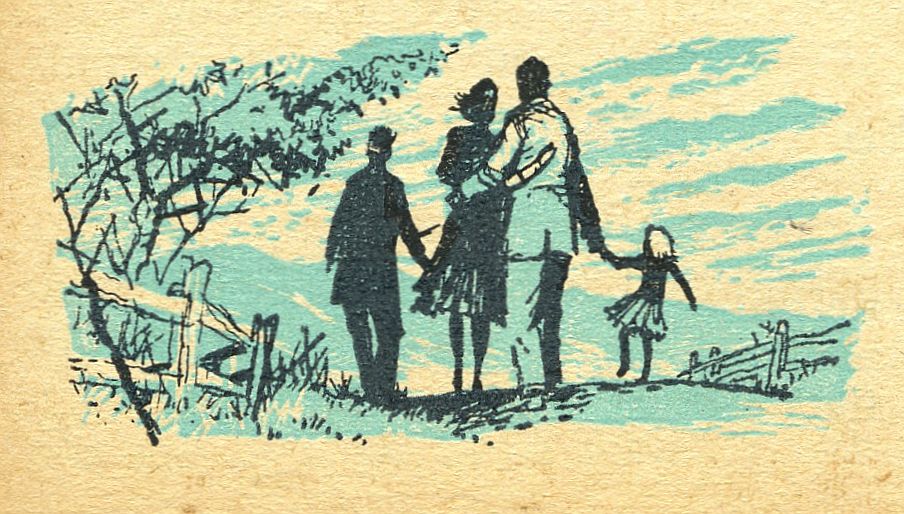 |
|
|

|
"Forbidden Beach" oil painting by Igor Gouzenko while at Camp X with his family - dated 1946. |
I acquired this painting in early summer of 2009 from a fellow in British Columbia who had had it for many years. It was in poor condition and had it restored by a local expert. I hope to add more insight into the painting itself in the near future. It is interesting to note that the essence of the painting with a title such as "Forbidden Beach" is a reflection on what life became for Igor Gouzenko and his family after his defection. |
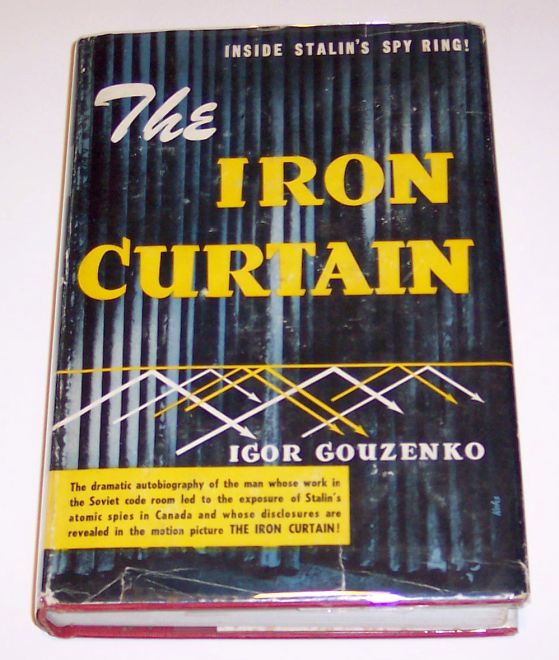
|
"The Iron Curtain" (279 pages) published by Dutton - 1948. |
On the inside flap, we have the following entries: "A smashing exposé and dramatic autobiography, The Iron Curtain is the story of a Soviet cipher expert who discovered the free world and blasted wide open Stalin's atomic spy ring in the nation he was sent to destroy." "Igor Gouzenko, son of a Russian schoolmistress of peasant stock, rose in the Communist Party through his intelligence, to become head cipher clerk at the Soviet Embassy in Ottawa. In 1946 his daring exposure laid bare the Soviet spy ring to the eyes of a shocked world when he fled to the Canadian authorities with incontrovertible proof against the Canadian betrayers." "In the The Iron Curtain Gouzenko reveals the scope and insidiousness of the hostile network of spies and subversives radiating from this Soviet Embassy. His work placed him close to the center of the espionage web, and across his desk passed a stream of correspondence between Moscow and Ottawa, and between the Soviet Embassy and Canadian Communists adn fellow-travelers acting as its agents." "At great risk to himself and his family, Gouzenko selected and smuggled out a mass of evidence. This resulted in the conviction and imprisonment of a number of Canadian in high places." "In the The Iron Curtain Gouzenko pictures in detail the hunger, the poverty, the corroding fear that govern the daily lives of millions of Russians. He brings out the extreme difficulty of trying to reach the Russian people with the truth. Their indoctrination has been so constant from birth that even he, with his superior opportunities, until he came to Canada could not possibly believe in a country where workmen had enough to eat three times a day, had more than one pair of shoes, had cars of their own." "The Iron Curtain is important, too because of the light it sheds on Soviet propaganda, both domestic and foreign. Gouzenko shows how the rulers of the Kremlin must keep the U.S.S.R. sealed off from the outside world in order to win gullible foreign sympathizers with the mirage of a mythical Never-Never Land." "Igor Gouzenko's disclosures have been revealed in the motion picture The Iron Curtain, released by Twentieth Century-Fox, starring Dana Andrews and Gene Tierney." |
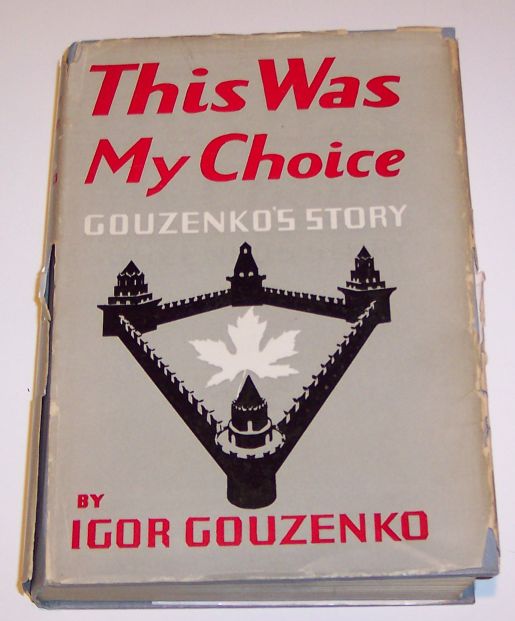
|
"This Was My Choice - Gouzenko's Story" (323 pages) published by Dent - 1948. |
On the inside flap, we have the following entries: "You may say or write what you like about this book and its author. As publishers we rejoice that this is so. "It is one of the most cherished rights of free citizens in a democracy." "The author, Igor Gouzenko, who was born and grew up under the Soviet regime in Russia, never knew that it was possible for anyone to speak and write as he wished until he came to Canada. As a cipher clerk in the Russian Embassy in Ottawa, from 1943 to 1945, he observed with amazement the freedom of speech enjoyed by Canadians. But this was ony one of the first and most impressive aspects of democratic life to astonish him." "Contact with our free way of life eventually caused Gouzenko to risk his life in order to warn the Canadian people of the jeopardy in which their freedom stood because of the activities of Soviet espionage agents in Canada." "If the Canadian way of life astonished Mr. Gouzenko, Canadians in their turn will be amazed by his picture of life in Soviet Russia. From his own experience the author describes living and working conditions as they exist for the ordinary citizen under the Soviet system. He also describes the organization, techniques and scope of Soviet Intelligence throughout the world, with special emphasis on its activities and successes in Canada during the late war." "In telling his own personal story, Igor Gouzenko presents an absorbing and often touching narrative which reaches its climax in his account of those tense hours through which he lived after making his escape from the Soviet Embassy and before he was given the protection of the Canadian authorities." |
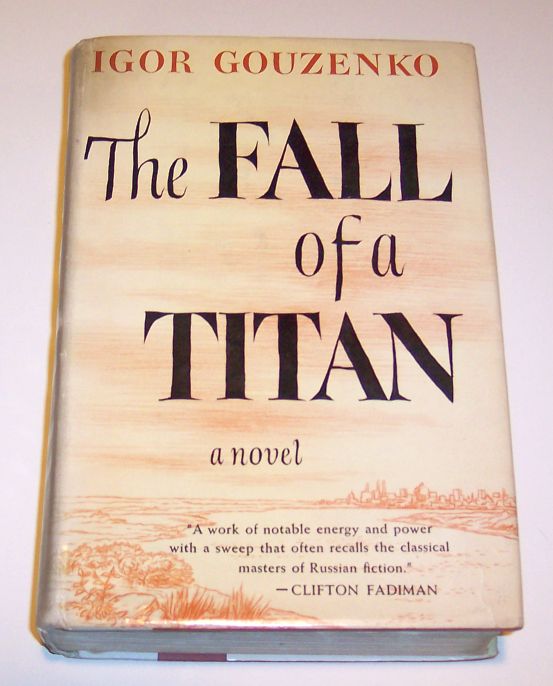
|
"The Fall of a Titan" (629 pages) published by Norton - 1954. |
The back cover states: "Although he has been constantly described as a cipher clerk, which of course he was, the fact has been lost sight of that he was a highly educated man with a wide knowledge of history and literature, and a serious student of world affairs". So reported The New York Times after an interview with Igor Gouzenko. It was his widowed mother, a school teacher, who instilled in Igor his love for learning, as his grandmother, who took care of him until he was six, instilled in him his love for the storyteller's art. Because of his brilliant scholastic record, Igor was enabled to study art and architecture at the Moscow Architectural Institute. He was twenty-two, in his third year at the Institute, when Russia entered the war in 1941. Again because of his excellent marks, he was sent to the Military Intelligence Academy in Moscow, was graduated with the rank of lieutenant, and was sent in 1943 to Canada as code clerk in the Soviet Embassy. He met his wife Svetlana Gousev, the daughter of a civil engineer, when they both were students at the Architectural Institute. They have two children, both Canadian-born. When they made their famous break from the Soviets in 1945, Mr. Gouzenko took with him 109 secret documents. These papers, which broke a spy ring operating in Canada, Great Britain, and the United States, remain the only important documentary evidence of their sort ever secured. For the past nine years the Gouzenkos have been living under assumed names under the protection of the Royal Canadian Mounted Police. Although he wrote short stories in his youth, The Fall of a Titan is Mr. Gouzenko's first novel. It took him four years to write, and he is already at work on another novel. |
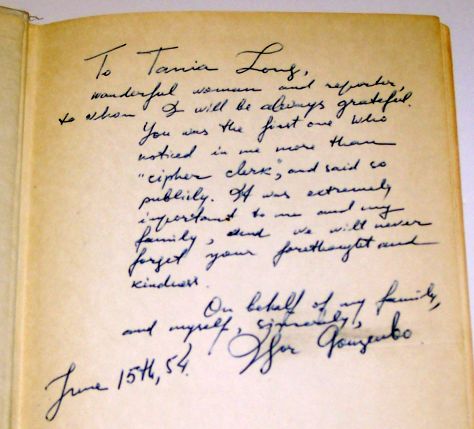
|
"The Fall of a Titan" - Gouzenko Inscription - 1954. |
This is a special copy of "The Fall of a Titan" with the following signed inscription by Igor Gouzenko: "To Tania Long, Wonderful woman and reporter to whom I will be always grateful. You were the first one who noticed in me more than "cipher clerk", and said so publicly. It was extremely important to me and my family, and we will never forget your forethought and kindness. On behalf of my family, and myself, sincerely, Igor Gouzenko (dated June 15th, 1954)." |
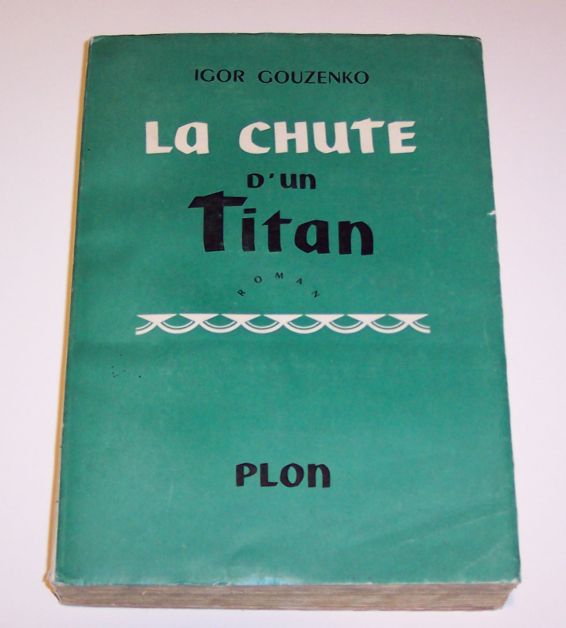
|
"La Chute d'un Titan" (453 pages) - 1955. |
Published by PLON. On the back cover, we have the following text (in French): Igor Gouzenko s'enfuit, le 6 septembre 1945, de l'ambassade des Soviets à Ottawa, où il était chargé du service du chiffre et choisit la liberté. Il emportait avec lui de précieux documents qui révélèrent aux autorités canadiennes l'existence d'un vaste réseau d'agents secrets au service du Kremlin. Le geste de Gouzenko entraîna l'arrestation du docteur Fuchs et des époux Rosenberg, pour ne citer que les plus connus. Protégé par la police canadienne et vivant dans l'anonymat, Igor Gouzenko est devenu écrivain. Son ouvrage La Chute d'un Titan est l'un des best-sellers dans les pays anglo-saxons. De nombreux personnages s'affrontent dans cette vaste fresque où l'auteur nous fait passer du Kremlin à l'Université, de la vie de professeur à la vie d'ouvrier. Le personnage central est Mickaïl Gorine, un grand écrivain. Entre lui et le professeur Fiodor Novikov se joue un drame poignant. Gorine, Le "Titan" des lettres russes, est sur la fin de sa vie ; il éprouve des doutes et cette attitude inquiète les membres du Politburo. Novikov est chargé de remettre l'écrivain vieillissant dans le droit chemin. Les péripéties de ce duel à mort sont contées avec une violence de ton et une justesse d'observation qui saisissent dès les premières pages. On devine que Mikhaïl Gorine, c'est Maxime Gorki. Romancé, il n'en demeure pas moins très semblable au vrai Gorki et l'évocation de cette grande figure et des circonstances qui entourèrent sa mort fait qu'on ne sait au juste où s'arrête la réalité, où commence la fiction. |
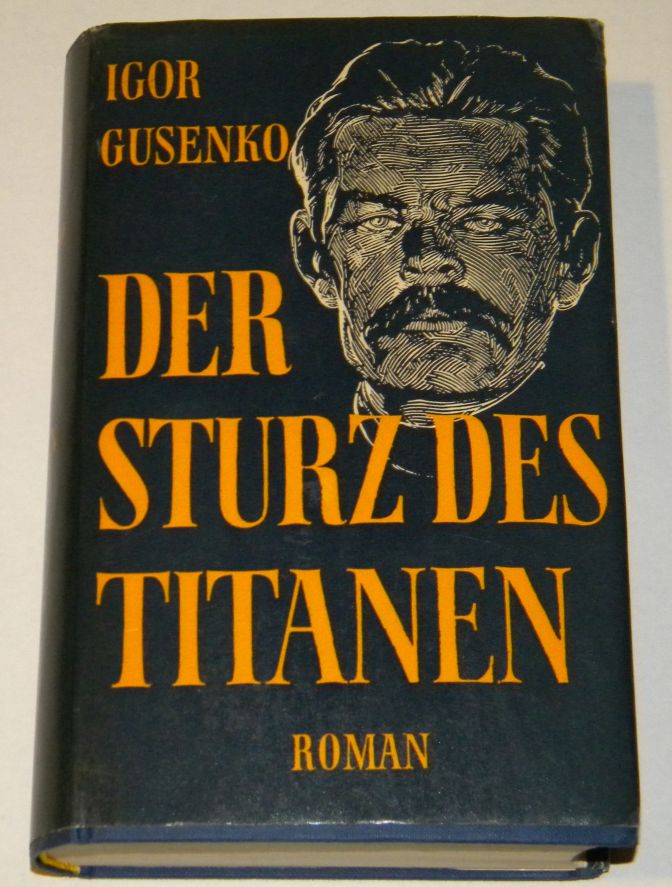
|
"Der Sturz Des Titanen" by Igor Gusenko (531 pages) - 1955. |
Published by Verlag Heinrich Scheffler. On the inside flap, we have: Am 5. September 1945 schnitt ein Chiffrierbeamter der Sowjetbotschaft von Ottawa jede Verbindung zwischen sich und seinem Lande ab, während er 102 Geheimdokumente aus der Botschaft herausschmuggelte. Sie enthüllten alle Verzweigungen des kommunistischen Atomspionage-Ringes. Damals lebten Kanada und die ganze westliche Welt noch in der Illusion der Sowjet-Waffenbrüderschaft. Der lästige Überläufer wurde zunächst nicht mit offenen Armen aufgenommen, und es drohte ihm die Auslieferung an den NKWD seiner Botschaft. In einem dramatischen Wettlauf mit dem Tode gelang ihm schlißlich doch der Nachweis der Echtheit dieser Dokumente. Seine bewahrte ihn vor dem Äußersten, und Guzenko fand ein neues Vaterland. Unter falschem Namen lebt er mit seiner Familie in einer kanadischen Stadt. In der Abgesschlossenheit dieses Lebens begann Igor Gusenko dor fünf Jahren mit der Niederschrift eines umfangreichen Romanes, der das Leben in Sowjetrußland zeigen sollte, wie wirklich ist. Der Roman erschien im Juli 1954 in englischer Sprache und wurde sogleich begeistert aufgenommen. Seit dem Erscheinen wurden in den Vereinigten Staaten und dem britischen Empire weit mehr als 100 000 Examplare von diesem Roman verkauft, mehr als dreißig Wochen lang stand er an führender Stele der »Best-seller-List«, und bald erwarben Verleger in fast allen Kulturstaaten die Übersetzungsrechte. Im Mai 1955 erhielt Gusenko den höchsten kanadischen Literaturpreis für sein Werk. Das ganze Leben des Verfassers Igor Gusenko in der Sowjetunion liegt hinter diesem ROman. Die Erzählung beginnt in den blutigsten Tagen der Revolution. Die Rote Armee dringt in Rostow am Don ein, beschlagnahmt Eigentum, dämmt die Flut der Fliehenden und zwingt sie zur Arbeit und zum Kampf für die Revolution. Unter diesen Menschen befindet sich auch ein junger Bursche, Fjodor Nowiko, der gezwungen wird, für die seiner Familie feindliche neue Macht zu arbeiten und zu kämpfen. Er wird nach dem Tod seines Vaters in den Bürgerkrieg hineingezogen, um an dessen Ende als Vertrauensmann der Tscheka die Erlaubnis zum Studium zu erhalten. Aber niemals wird der Geheimdienst ihn freigeben: Nowikow macht Karriere durch eine Arbeit über die alten Slawen und wird Professor. Ein plötzlicher Besucher aus Moskau versieht ihn bald darauf mit einer Sonderaufgabe. |
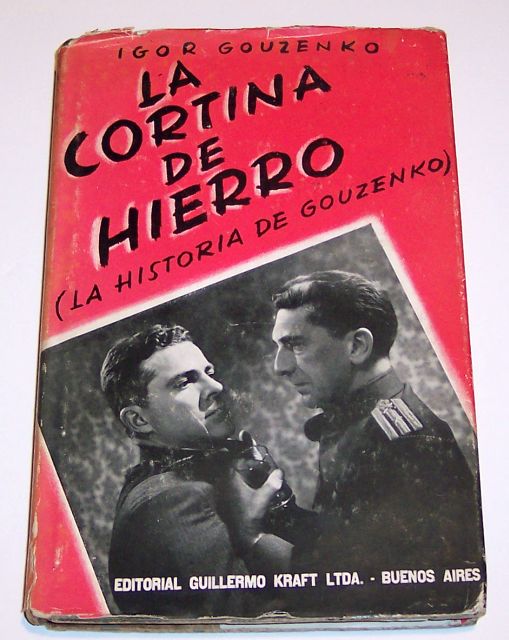
|
"La Cortina de Hierro - La Historia de Gouzenko" - No date, circa 1948. |
Titulo original de esta obra: "This was my Choice". Puede el lector decir o escribir lo que le plazca respecto de este libro y de su autor. Como editores nos alegramos de ello porque al harcerlo ejercita uno de los más caros derechos inherentes a todo libre ciudadano que habita en una democracia. El autor, Igor Gouzenko, que nació y se educó en Rusia bajo el régimen soviético, jamás creyó que fuera posible hablar y escribir según sus propios deseos, antes de arribar a Canadá. Descifrador de claves en la Embajada rusa en Ottawa desde 1943 hasta 1945, comprobó asombrado la libertad de expresión de que gozan los canadienses. Pero ello fué tan sólo uno de los primeros y más impresionantes aspectos de la vida democrática que llamaron su atención. Su posterior contacto con nuestra libre manera de vivir, lo impulsó a arriesgar su vida para prevenir al pueblo canadiense respecto del gran peligro que corrían sus libertades, a causa de las actividades de los espias soviéticos en Canadá. Las normas de vida de los canadienses impresionaron a Mr. Gouzenko, pero aquéllos, a su vez, se asombraron al conocer su pintura de la vida rusa. Valiéndose de su propia experiencia describe el autor las condiciones de vida y trabajo imperantes en la Rusa soviética, así como también la técnica y alcance del Servicio de Inteligencia ruso en todo el mundo. Sobre todo recalca en esete libro las actividades y los éxitos obtenidos por aquél en Canadá durante la última guerra. Al narrar su propia historia presenta Igor Gouzenko un atractivo y, por momentos, conmovedor relato que llega a su puonto culminante en las tensas páginas en que describe los episodios de que fué protagonista, luego de huir de la Embajada soviética y antes de lograr la protección de las autoridades canadienses. |
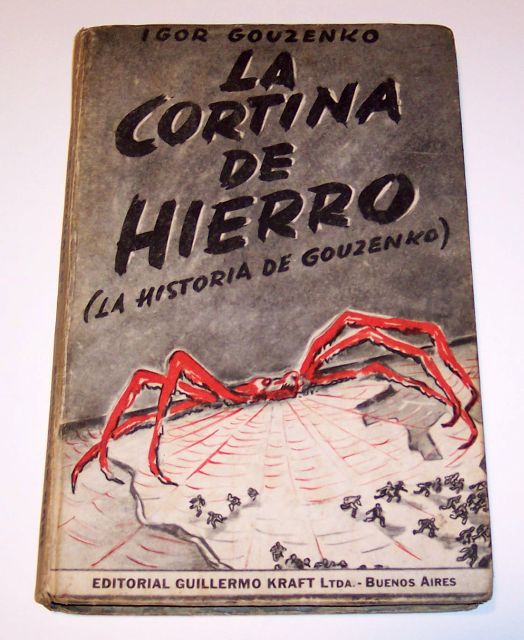
|
"La Cortina de Hierro" Igor Gouzenko - No date, circa 1948. |
Titulo original de esta obra: "This was my Choice". Introduccion - de la edicion original canadiense. Mientras este prefacio va adquiriendo forma, un hombre, junto con su familia, vive constante y estrechamente vigilado por una guardia de la Real Policia Montada canadiense. Sólo unos pocos altos funcionarios gubernamentales y oficiales de policia saben qué punto del mapa canadiense representa su casa. Vive bajo un nombre supuesto y, tal vez, disfrazdo. Estrictas medidas de seguridad prohiben la reproducción de su fotografia, sus detalles personales o cualquier indicio vinculado con el sitio en que se halla. A als entrevistas relacionadas con la edición de este libro concurrió bajo escolta policial a diferentes sitios de distintas ciudades. El hombre se llama Igor Gouzenko y se halla hoy enteramente protegido por la ley canadiense. Es un súbdito británico al cual escuda el sólido sistema de seguridad de un pais libre, que garantiza su tranquilidad y la de los suyos. Dentro de tan extraordinarias precauciones se halla en juego algo más que la mera protección de Igor Gouzenko. Necesario será recalcar, hasta que no quede un solo ciudadano en un pais libre sin comprenderlo, que tales medidas nos han sido impuestas por el descarado y mortal desafio que el reino del terror, del temor y de la negación de libertad y la conciencia individuales y de los derechos y privilegios humanos, ha lanzado a los hombres libres de todo el mundo. La horripilante serie de hechos constituida por las purgas, los campos de concentración, las ejecuciones en masa y las torturas individuales fué escrita, por primevera vez, con la sangre del propio pueblo ruso, de la misma manera que Hitler sació primero su diabólico anhelo de poder con los cuerpos deshchos y los ensangrentados cadáveres del pueblo alemán. |
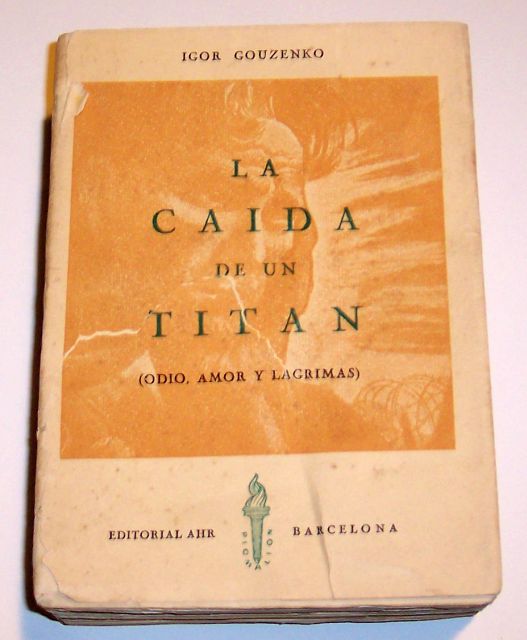
|
"La Caida de un Titan" Igor Gouzenko - 1956. |
Igor Gouzenko nació durante el torbellino de la Rusia post-revolucionaria, un año después de haber muerto su hermano de inaninción. Fué educado en el Estado soviético. Durante veinticinco años se vió imbuído por la doctrina comunista... y vió el resultado en los sufrimientos humanos. Hijo de un maestro de escuela de ascendencia campesina, se convirtivió, después de años de duro estudio, en un oficial de confianza del Servicio Secreto soviético. La vida entera de Igor Gouzenko en la Unión soviética se nos revela enteramente en esta novela tan impresionante. La cludad de Rostovon-Don, en la cual se sitúa la acción, es la cludad en la que vivió Gouzenko. La gente cuyas vidas llenana estas páginas, son seres vivientes, que vivieron, amaron y temieron bajo el ojo todopoderoso del Kremlin. Pero entre todas las mujeres y los hombres que nos son relatados aquí, dos sobresalen entre los demás: el idealista Gorin, estrechamente ligado a Máximo Gorki, cuyos primeros escritos inspiraren a los revolucionarios... el amigo de Lenin que asistió al crecimiento del poder de Stalin desde el extranjero y regresó luego a Rusia para enfrentarse con la realidad y donde encontró que sus fervientes creencias eran destruídas por una tiranía brutal; y Novikov, el oportunista, obligado en su juventud a unirse a los revolucinarios en contra de su propia clase social educándose, paso a paso, en aquella brutalidad sin la cual no es posible confiar en escalar una posición destacada en la jungla de la política del Partido. Este estudio del nuevo hombre soviético es genial, es verídico, su horror se hace evidente a todos. Es él, quien por órdenes recibidas del NKVD, y por recibir en compensación un ascenso, ha de devolver a Gorin al ambiente ideológico. Y la misión de Nivikov es el tema en que se basa esta novela; su camino, mientras Novikov se abre paso en la confianza de Gorin, es de una tensión tan inmensa, que su única rotura puede significar la muerte. Pero el tema de este libro es muy amplio Es una imagen completa de la vida en la Rusia soviética, de sus caracteres que nos revelan todas las facetas bajo la mano dura del Estado soviético, hombres y mujeres de carne y hueso, hombres y mujeres al igual que nosotros que viven en condiciones que hicieron que Gouzenko, cuando vislumbró la vida libre en el Canadá, arriesgara todo lo que poseía, para escoger la libertad. Gouzenko vive ahora oculto bajo la protección del Gobierno canadiense en el Canadá. Este cuadro an humano de la vida en que nació, de todos aquellos que están sometidos al comunismo, dejará una memoria imborrable en la mente de todos aquellos que lean este libro. |
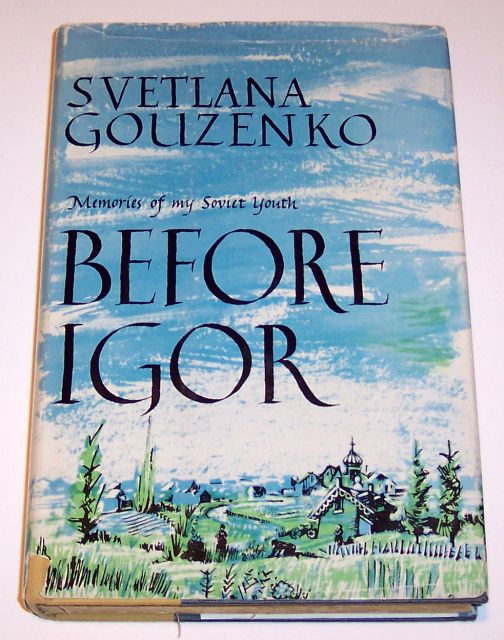
|
"Before Igor - Memories of my Soviet Youth" - 1960. |
Written by Svetlana Gouzenko, this 252-page book has a signed inscripton inside the book by the author. It states "To Allen Spraggett, creator of my favourite radio-programme, wish you all the luck Jupiter can give you - Svetlana Gouzenko, 31/1 - 1974." The following entry on the inside dust jacket: "Svetlana Gouzenko was born in the Soviet Union soon after the Revolution. She grew up in the stormy early years of terror and want, but they were also years of youthful excitement and adventure. With fear and political intrigue not far in the background, she and her family lived colorful, dramatic lives. With warmth and a natural give for narrative, she tells the story of her delightful family, their laughter, their love and their struggle to survive in a turbulent land. Svetlana, daughter of an engineer, and on her mother's side descended from the Polish patriot Kosciusko, spent most of her childhood in Moscow. But with her family she traveled to the remote corners of Russia - Turkestan, Siberia, Crimea, and the Arctic ports Archangel and Murmansk. She paints a vivid picture of her homeland and describes with humor and nostalgia her own adventures - the trip through a Siberian blizzard when the sleighs were guided to shelter by the smell of borscht, her meeting with Stalin's strong-willed daughter, her encounter with a fiery mountaineer who wanted her for a bride. Full of color and contrast, of gaiety and tragedy, her story is a reminder of the tenacity of the human heart. Although Mrs. Gouzenko ends her book with her first meeting with Igor Gouzenko, she has led an eventful life since. During the war she left the Moscow Institute of Architecture to work on the front lines in a labor brigade and for a time trained as a fighter pilot. In 1942 she married Igor and in 1943 they were sent to Canada to work in the Soviet Embassy in Ottawa. Two years later, they made their dramatic flight from the Embassy, taking with them the documents that revealed an international network of Soviet espionage. The spotlight once again focused on the Gouzenkos when Igor wrote The Fall of a Titan, a novel of Soviet life that received worldwide acclaim. With their two children, the Gouzenkos live in seclusion under the protection of the Canadian government. Mrs. Gouzenko is already planning a continuation of her memoirs, while her husband is at work on his second novel." |
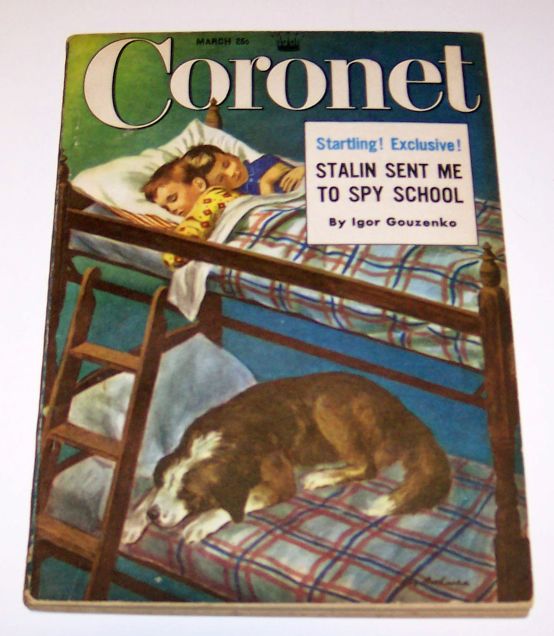
|
"Stalin Sent Me to Spy School" - March 1953. |
This was an 8-page article (by Igor Gouzenko as told to Anne Fromer) in the Coronet magazine. The foreword is as follows: "Late one night in the code room of Soviet spy headquarters for North America, Igor Gouzenko put a carefully prepared plan into action. He slipped 109 secret documents into the lining of his coat. Then he walked out of the building - the Soviet Embassy in Ottawa - for the last time. Why did Gouzenko voluntarily change his allegiance to democracy? What single incident convinced him that the Soviet cause he was serving was false? In this article, are the answers. Here, for the first time, Igor Gouzenko tells the story of one of the most sinister adventures of our time" - The Editors." Here are all pages scanned for your reading benefit: |
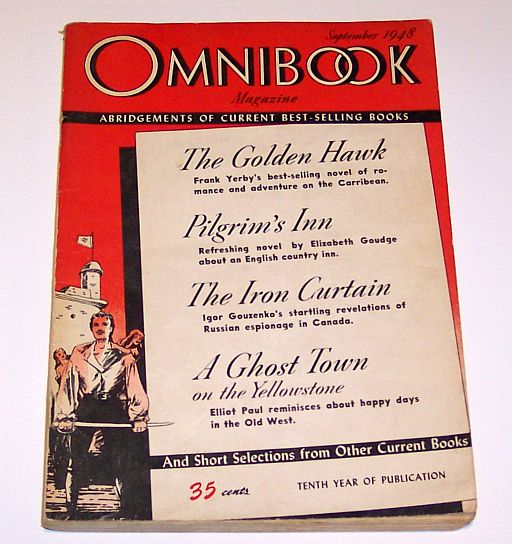
|
"The Iron Curtain" article in Omnibook edition of September 1948. |
This was a 20-page article (abridged by Igor Gouzenko from his book by the same name) in the Omnibook magazine. Here is part of the "Omnibook Foreword" by the publishers: "When a howling mob of Red sympathizers swirled around the movie palace where Igor Gouzenko's Communist spy revelations in "The Iron Curtain" were being premiered, it became glaringly apparent that the former Embassy code clerk had probed a highly sensitive nerve by his exposé of Moscow's subversive attacks on Western civilization. The louder the pickets cried the more obvious it became that the movie based on Igor Gouzenko's life really had something to say. And now The Iron Curtain, containing much of the movie's material and more, is published as an authoritative printed account of one of the most startling spy stories of modern times." "The Iron Curtain tells how Igor Gouzenko, cipher clerk of the Soviet Embassy in Ottawa, Canada, risked his life and the safety of his family to reveal the attempts of the U.S.S.R. and its Canadian accomplices to gain vital atomic bomb secrets, even before Hiroshima and Nagasaki were destroyed." "Finally in the fall of 1945, the young Russian took his life in his hands by smuggling from his files key documents which later convicted a number of Canadians of sying for Russia and ripped a hole in the iron curtain hiding Soviet fifth-column activities from the eyes of the democratic peoples of the world. Gouzenko spent frantic hours trying to get the incriminating papers into the hands of the proper authorities, while Soviet secret service men besieged his apartment and finally forced their way in in a desperate effort to recover the papers. His disclosure of the world-wide ramifications of Soviet espionage did much to shock Americans out a complacent attitude toward our supposed sole possession of the atom bomb." In this article, the Editors have added the following: About Igor Gouzenko: Born in Rogachov near Moscow in 1919, Igor Gouzenko grew up under Soviet rule. He became a Communist Party member during World War II. On coming to the Canadian Embassy in 1943, he looked with wonder on the privileges and comforts of the common working man, and these things led his disillusionment with the Soviet way of life. After turning over evidence to the Canadian authorities which convicted a number of Canadian citizens, Mr. Gouzenko and his family were placed under the protection of the Canadian police. Right now their identity and whereabouts are carefully concealed, and all that is known is that the Gouzenkos are living "somewhere in Canada". Here is a scan of the first two pages of the article in question. |
|
|
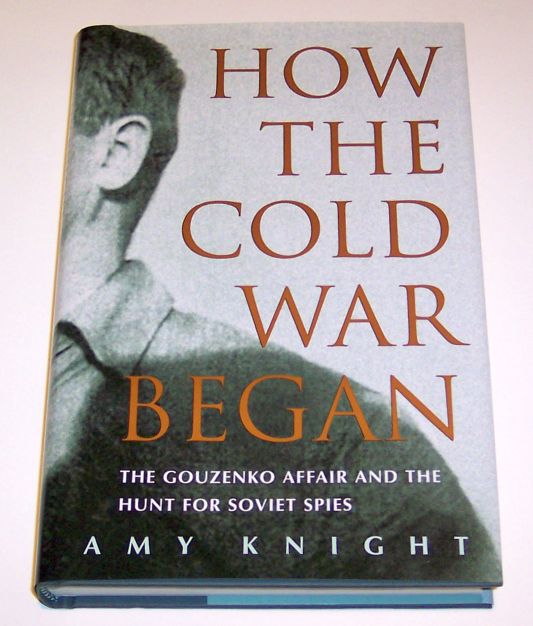
|
"How the Cold War Began" (258 pages) - 2005. |
Written by Amy Knight and published by McClelland & Stewart and you can access a number of portions of this book online at this Google Books link. On the inside flap, we find the following entry by the publishers: "Just weeks after the Second World War ended, a young Russian cipher clerk named Igor Gouzenko walked out of the Soviet Embassy in Ottawa with secret papers stuffed under his shirt and headed straight for the offices of a city newspaper. His unprecedented action would change the course of the twentieth century." "Gouzenko's defection sent shock waves far beyond the Canadian capital and launched an international witch-hunt for spies. The documents he smuggled out with him that day suggested Soviet agents - among them leading British nuclear scientist Alan Nunn May - were stealing atomic secrets from the West. In Washington, FBI chief J. Edgar Hoover seized upon the news. All he had needed to demonize the Soviets and discredit White House liberals was evidence of Soviet spying, and Gouzenko delivered the goods. The FBI and the House Un-American Activities Committee were soon using Gouzenko's revelations to hound Alger Hiss, Harry Dexter White, and many others. And all the while in London, double-agent Kim Philby was keeping his Soviet masters in Moscow apprised of every new development in the extraordinary affair. The Cold War had truly begun." "Using newly declassified intelligence files and interviews with several of the key players, Amy Knight examines the substance of Gouzenko's revelations and delves into his hidden motives for defecting. She explains how Gouzenko, the RCMP who protected him and interrogated suspects for weeks without laying charges, and Prime Minister Mackenzie King's government were really pawns in a much larger game. And she brilliantly connects these events to the hardening of political relations between Moscow and the capitals of the West, the practice of guilt by association, and the end of the movement for international control of the atomic bomb." |
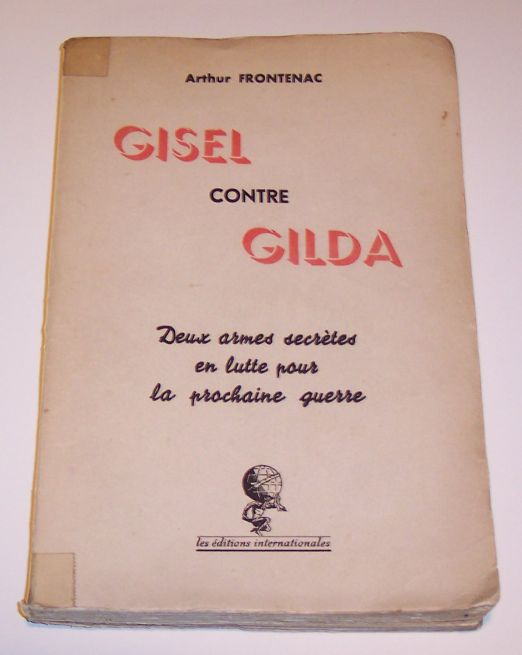
|
"Gisel contre Gelda - Deux armes secrètes en lutte pour la prochaine guerre" (233 pages) - 1948. |
Written by Arthur Frontenac and published by Editions Internationales. Here are some text extracts which detail a signed submission by Igor Gouzenko on 10 October 1945 (in French): "Je sousigné Igor Gouzenko, ai décidé, de mon propre chef, de faire la déclaration suivante: Arrivé au Canada voici deux ans, je fus surpris dès le début de mon séjour, de sa liberté individuelle absolue qui règne au Canada, alors qu'elle est inconnue en Russie. La fausse image des pays démocratiques, qu'on se forge en Russie, d'apris une propagande de plus en plus diffusée, céda jour après jour devant les faits auxquels nulle propagande mensongère ne résiste. En deux années de résidence au Canada, je pus voir ce dont est capable un peuple libre. Ce que les Canadiens ont accompli et continuent à accomplir ici dans les conditions de liberté absolue, le peuple Russe, sous le régime soviétique de violence et de suppression de toute liberté, ne peut y parvenir, même au prix de son sang, de ses larmes, et de ses sacrifices surhumains. Les dernières élections qui ont eu lieu récemment au Canada m'ont particulièrement étonné. Par comparaison, le système electoral russe apparaît comme une caricature de la notion d'élections libres. Par exemple, dans les scrutins de l'Union Soviétique, on ne présente qu'un seul candidat, en sorte que toute possibilité de choix est exclue. Ce fait seul est suffisamment éloquent. Tout en répandant une fausse image des conditions de vie en pays démocratique, le gouvernement soviétique met tout en oeuvre pour empêcher les habitants de ces pays d'être renseignés sur les conditions de la vie en Russie. Les faits relatifs à la suppression brutale de la liberté de la parole, ou à la dérision des sentimenes religieux sincères des gens, ne peuvent être connus dans les pays démocratiques. Ayant imposé au peuple son régime communiste, le gouvernement de l'Union Soviétique prétend que le peuple Russe possède une notion particulière de la liberté et de la démocratie, différente de celle qui prévaut chez les gens des démocraties occidentales. C'est un mensonge. Le peuple russe a de la liberté la même notion que les autres peuples du mone. Mais le peuple russe ne peut réaliser son rêve de liberté et de gouvernement démocratique, par suite de la terreur et de la persécution la plus cruelle. Tout en paradant aux conférences internationales et en se répandant en propos abondant sur la paix et la sécurité, le gouvernement soviétique dans le même temps se prépare secrètement à une troisième guerre mondiale. Pour y faire face, le gouvernement soviétique organise dans les pays démocratiques, y compris le Canada, une cinquième colonne à la création de laquelle participent jusqu'aux représentants diplomatiques du gouvernement soviétique. L'annonce de la dissolution du Komintern fut probablement la plus grose farce des communistes dans les années récentes. Seul le nom disparut, aux fins de rassurer l'opinion publique des pays démocratiques. Le Komintern existe toujours et poursuit son oeuvre. Les chefs soviétiques n'ont jamais renoncé à l'idée d'établir une dictature communiste sur le monde entier. Le fait que cette aventure coûtera des millions de vies russes est ce qui préoccupe le moins les communistes. Ils s'emploient à inspirer au peuple russe de la haine pour tout ce qui est étranger. Aux yeux de nombreux citoyens soviétiques envoyés ici à l'étranger, il apparaît clairement que dans les pays démocratiques les Partis Communistes se sont depuis longtemps transformés de partis politiques en réseaux d'espionnage au bénéfice du gouvernement soviétique, en cinquièmes colonnes prêtes à la guerre dans ces pays, en instruments dociles aux mains des Soviets pour créer une agitation artificielle, faire de la provocation, etc... etc... Par le truchement des multiples agitateurs du parti, le gouvernement soviétique excite le peuple russe contre les populations des pays démocratiques de toutes les façons possibles, préparant ainsi le terrain pour la troisième guerre mondiale. Durant mon séjour au Canada, j'ai pu voir comment le peuple canadien et son gouvernement, dans un désir sincère de venir en aide au peuple russe, a envoyé du ravitaillement à l'Union Soviétique, collecté de l'argent pour le bien-être du peuple russe, et sacrifié la vie de ses fils dans le transport de ce ravitaillement au-delà des océans Au lieu de se montrer reconnaissant de l'aide apportée, le gouvernement soviétique développe au Canada dans le dos - tout cela hors de la connaissance du peuple russe. Convaincu que cette politique de double-jeu du gouvernement soviétique à l'égard des pays démocratiques n'est pas conforme aux intérêts du peuple russe et met en danger la sécurité de la civilisation, j'ai décidé de briser tout lien avec le régime des Soviets, et de publier ouvertement ma décision. Je suis heureux d'avoir pu trouver en moi assez de force pour sauter ce pas et pour prévenir le Canada et les autres pays démocratiques du danger qui est suspendu sur eux." --- Signé : Gouzenko. In addition, we are told of the following codenames:
|
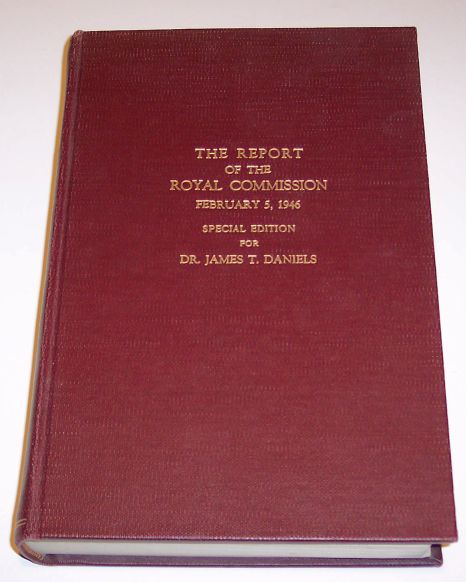

|
"The Report of the Royal Commission - The Gouzenko Case" (733 pages) - February 5, 1946. |
Hardcover special edition for Dr. James T. Daniels. |
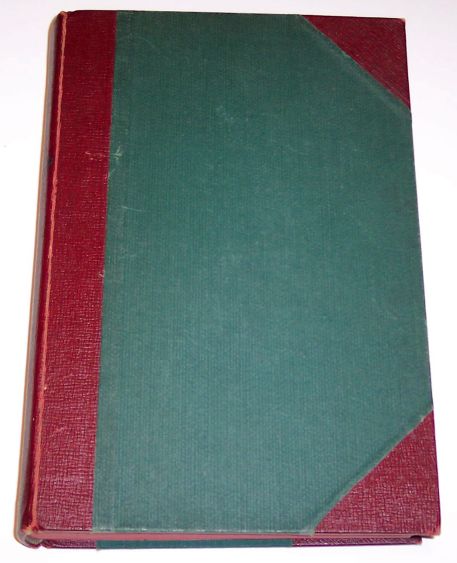
|
"The Report of the Royal Commission" (733 pages)- June 27, 1946. |
Hardcover edition (Campbell Haig copy). Here is a scan of first page of the table of contents. Here is a portion from Section II on page 11: Igor Gouzenko It was Igor Gouzenko who revealed the existence in Canada of a widespread conspiracy to obtain secret official information. Gouzenko, who had been sent to Canada in June, 1943, with the official title of "civilian employee" of the Soviet Embassy at Ottawa, was the cipher clerk on the staff of the Military Attaché, Colonel Zabotin. On the night of September 5th, 1945, Gouzenko left the Embassy with a certain number of documents from his own office, including telegrams sent to Moscow, others received from Moscow, which he had enciphered and deciphered, as well as other documents made either by Russian officials of the Embassy or by other persons living in Canada. After having gone through the experiences detailed in Sectin X of this Report, Gouzenko eventually told his story to the R.C.M.P., who reported to the Canadian Government. He has undoubtedly been a most informative witness and has revealed to us the existence of a conspirational organization operating in Canada and other countries. he has not told us the names and cover names of the organizers, the names of many of the Canadians who were caught "in the net" (to employ the phrase used by the documents) and who acted here as agents, but he has also exposed much of the set-up of the organization as well as its aims and methods here and abroad. There can be no doubt in our minds that these attempts, very often successful, to obtain here secret and confidential information cannot be qualified as casual or isolated. They are merely the acts of overzealous Soviet employees anxious to inform their own Government. The set-up of this organization in Canada is the result of a long preparation by trained and experienced men, who have come here for the express purpose of carrying on spying activities, and who have employed all the resources at their disposal, with or without corruption, to fulfill the tasks assigned to them. Some of these men have undoubtedly been well-schooled in espionage and Fifth Column organizational methods, and in political and psychological "development" techniques. Gouzenko himself came to Ottawa only after he had been through the training that his superiors thought essential for the work he was chosen to perform. At 16 he was a member of the Komsomol or "Young Communist League", which is a youth movement controlled by, and preparatory to membership in, the Communist Party. He was instructed first in coding and decoding in a secret school after having been investigated by the N.K.V.D., which is the official secret political police of the Soviet Union , access to secret cipher work. He was later transferred to the Main Intelligence Division of the Red Army in Moscow, where he spent one year. During that year he saw, in the course of his work, a large number of telegrams to and from many countries, detailing operations there similar to those which he has disclosed in Canada. Finally, after further investigation, Gouzenko was sent to Canada. Secrecy Gouzenko has described to us the extreme secrecy in which the espionage operations were conducted here. He lived with his familyat 511 Somerset Street, Ottawa, but he had his own office in the secret cipher department which is located on the second floor at the Embassy, No. 285 Charlotte Streeet. He worked in room 12, one of the eight rooms on the second floor of a wing of the building, the entrance of which is closed by a double steel door, and the windows of which have iron bars and steel shutters which are closed at night for the purpose of complete secrecy. In this room is a steel safe which contains many of the important documents of the Military Intelligence. The cipher books which Gouzenko used to cipher and decipher telegrams, were kept in a sealed bag which was handed every night to one Aleksashkin, and in the same bag were also placed the telegrams that came from Moscow and the telegrams sent to Moscow. In the safe were kept the agents' records, Colonel Zabotin's secret diary, and other documents of the Military Intelligence Service. From time to time, some of these documents were destroyed in an incinerator located in room 14. |
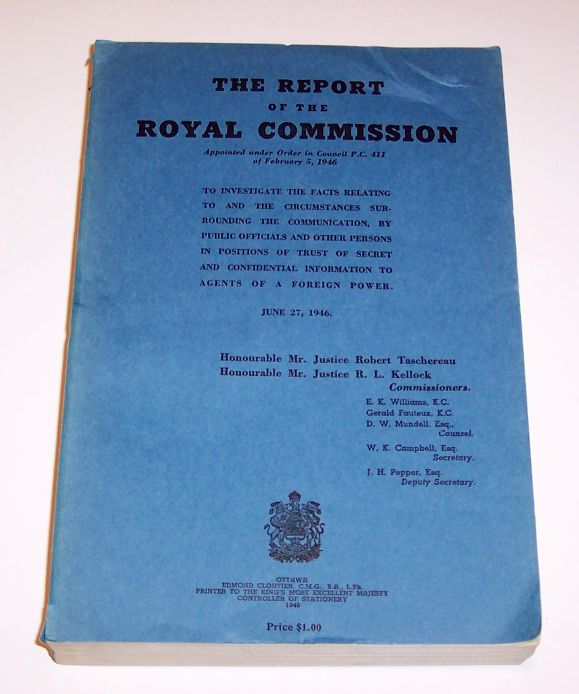
|
"The Report of the Royal Commission" (733 pages) - June 27, 1946. |
Standard blue softcover edition. |
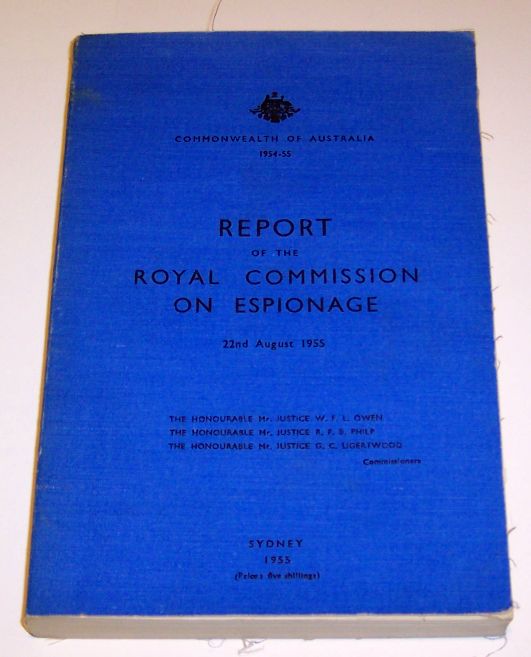
|
"The Report of the Royal Commission on Espionage - Australia" (733 pages) - 22 August, 1955. |
Standard blue softcover edition. Here is an entry with reference to Igor Gouzenko in Chapter 3 (pages 24-25): #64. As to the charge of embezzlement made in the Soviet Note, the Department of External Affairs requested detailed particulars of fit, but none were supplied. This charge was not renewed by anyone before us; Petrov vehemently denied it and there was no evidence whatever to support it. It is noteworthy that a similarly belated and false charge of embezzlement of Embassy funds was made by the Soviet Government against Gouzenko after his defection in Canada in 1945 (Report of the Royal Commission on Espionage in Canada, at pages 645-646). |
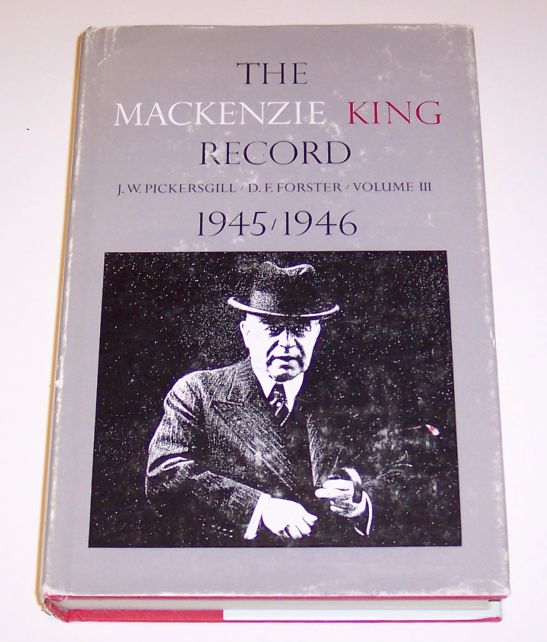
|
"The Mackenzie King Record - Volume III (1945-1946)" (424 pages) - 1970. |
Written by J.W. Pickersgill and D.F. Forster and published by University of Toronto Press. On the inside flap, we have the following entry: Volume III begins after the war has ended, and begins dramatically with a long account of the Gouzenko case. Its implications were felt in many areas, one of them being international relations in the difficult months after the end of the hostilities when the western allies were endeavouring to find ways of working with the USSR to form peace treaties and organize the United Nations. The awesome shadow of the atomic bomb is cast over most of the many discussions which the Prime Minister and his advisers have with the United States: Atlee, Churchill (the famous Fulton address is reported fully), Eden, Lord Addison, Bevin, Truman, Acheson. Chapter 2 titled "The Gouzenko Affair" is 40 pages long. Of note on pages 7-8: Parliament was to meet at 11:00 A.M. on September 6 so that the House of Commons could elect a speaker before the formal opening that afternoon. When the Prime Minister arrived at his office about 10:45 A.M. he was surprised to find Robertson and Wrong waiting for him. In his special secret diary he noted that both were looking very serious. "Robertson said to me that a most terrible thing had happened. It was like a bomb on top of everything and one could not say how serious it might be or to what it might lead. He then told me that this morning, just half an hour or so earlier, a man had turned up, with his wife, at the office of the Minister of Justice. He asked to see the Minister. He said he was from the Russian Embassy. That he was threatened with deportation and that once he was deported, that would mean certain death. That the Russian democracy was different than ours. "He went on to say that he had in in his possession documents that he had taken from the Embassy and was prepared to give to the Government. They would be seen to disclose that Russia had her spies and secret service people in Canada and in the U.S. and was practising a species of espionage. That some of these men were around Stettinius in the States, and that one was in our own Research Laboratories here (assumedly seeking to get secret information with regard to the atomic bomb). He indicated that he had had to do with the cyphering of messages. Robertson was not sure that he did not have the cypher code book with him. At any rate, he said that he had enough evidence there to prove that instead of being friends, the Russians were really enemies. "The Secretary [in the office of the Minister of Justice] had talked with Mr. St Laurent who thought it best not to see him. Robertson and Wrong were asking my advice, whether they should not have the mounted police take him in hand and secure the documents which he had. The man when he was told that the Minister of Justice would not see him, then said that he would have to commit suicide right there. There could be no hope for him because when the vault was opened at the Embassy, they would discover there that the papers had gone and would know that he had taken them. I said to both Robertson and Wrong that I thought we should be extremely careful in becoming a party to any course of action which would link the Government of Canada up with this matter in a manner which might cause Russia to feel that we had performed an unfriendly act. That to seek to gather information in any underhand way would make clear that we did not trust the Embassy. The man might be only a crank trying to preserve his own life. if he had information of the kind in his possession during the war, he should have given it to us at that time, if he had wanted to help the Government. It looked as though he was trying to make out a case which would cause our Government to protect him which, of course, he admitted he wanted. "Robertson seemed to feel that the information might be so important both to the States and to ourselves and to Britain that it would be in their interests for us to seize it no matter how it was obtained. He did not say this but asked my opinion. I was strongly against any step of the kind as certain to create an issue between Russia and Canada, this leading to severance of diplomatic relations and as Robertson pointed out, might have consequences on the meeting of the Council of Foreign Ministers which might lead even to the breaking up of that organization." |
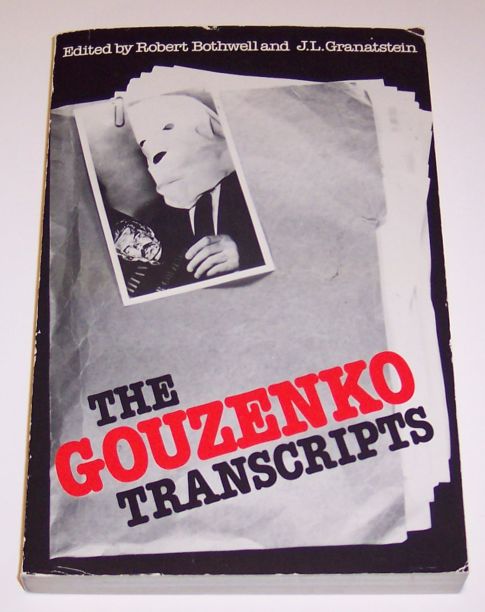
|
"The Gouzenko Transcripts" (346 pages) - June 27, 1982. |
Edited by Robert Bothwell and J.L Granatstein and published by Deneau Publishers. |
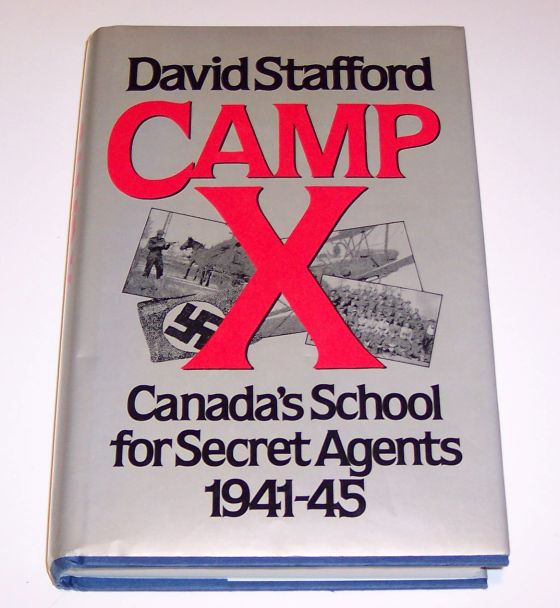
|
"Camp X - Canada's School for Secret Agents 1941-45" (327 pages) - 1986. |
Written by David Stafford and published by Lester & Orpen Dennys Publishers. Here are three paragraphs from this book: The Gouzenko case was the first important spy scandal of the postwar years and quickly gained status as a turning point in the emerging Cold War. As a result of Gouzenko's revelations several arrests were made in Canada. An atomic scientist, Alan Nunn May, was detained and then imprisoned in Britain, and in the United States investigations began that led ultimately to the executions of Julius and Ethel Rosenberg as Soviet spies in 1953. In spite of the remarkable consequences of his act, Igor Gouzenko was a relatively insignificant figure. It was less what he knew than what he brought with him that was important, and even now, forty years later, reverberations of the Gouzenko affair are felt whenever allegations about the presence of Soviet moles in the West are raised. He was a twenty-six-year-old cipher clerk working for Soviet military intelligence (GRU) in the Soviet Embassy in Ottawa when, on the night of September 5, 1945 - less that a month after Hiroshima and Nagasaki - he left the embassy with documents revealing details of extensive espionage the USSR conducted against its wartime Allies. At first Gouzenko encountered great difficulty in interesting people in what he had to offer, and he was turned away from both newspaper and government offices. The events surrounding his defection, and the subsequent trials in Canada and elsewhere, are now well known, but at the time, when Canadian officials realized the significance of his material, the case was kept from public knowledge for a combination of operational and political reasons. From September on, Gouzenko and his family were kept under close wraps, under the protection of the RCMP. For cover purposes, those involved in the case were told that he had been taken "up north". In fact the exact opposite was true. For most of the time the Gouzenko family were well to the south, hidden away at Camp X. The reason lay in Stephenson's direct involvement in the whole affair. By an accident of timing, which in retrospect must have appeared miraculous to those involved, Stephenson was on a routine visit to Ottawa the night Gouzenko spent wandering around looking in vain for asylum. From the exclusive Seigniory Club in Montebello, Stephenson phoned Norman Robertson, the under-secretary at External Affairs, to invite him for a drink. Instead within hours he found himself closeted with Robertson and Tommy Stone while the "Man of Influence" poured out his troubles and sought his advice. The problem, as always, lay the Canadian prime minister. Exhibiting his customary distaste for spying and undercover work, King had said tha he did not want Canada to get involved with Gouzenko at all. So far as he was concerned, he had told Robertson, they should let Gouzenko wander aroudn until he either went back to his embassy or committed suicide. "If suicide took place", King confided to his diary, "let the city police take charge and secure whatever there was in the way of documents, but on no account for us to take the initiative. If Canada got involved officially, it could only mean a further deterioration of relations with the Russians. Stephenson vigorously opposed King's view. ... |
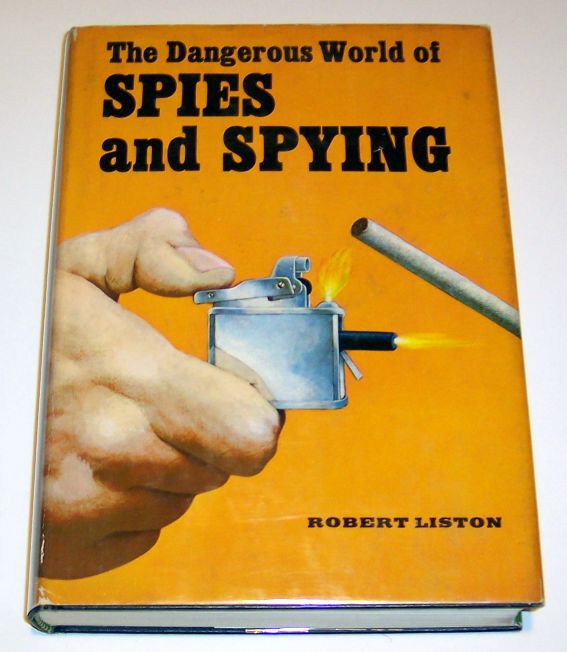
|
"The Dangerous World of Spies and Spying" (274 pages) - 1967. |
Written by Robert Liston and published by Platt and Munk Publishers. Of particular interest is chapter 12 titled "Spies who `go over'" from which the following paragraphs are quoted: One defector is worth a dozen average spies. Hayhanen, a paid, highly trained Soviet agent in a sensitive plot, defected to the United States and told enough to lead to the capture of Rudolf Abel, a top Russian spy of the 1950's. he illustrated how one defector can reveal in a minute information that would require years to learn by customary intelligence methods. He can expose organizations, unmask fellow spies, identify leaders, describe secret operations, break codes, tell about dead drops and safe addresses. One defector can create havoc in a complex spy apparatus. ... The postwar round of defections really started in September 1945, when Igor Gouzenko, a cipher clerk in the Soviet Embassy at Ottawa, scooped up an armful of secret documents and tried to defect. Stalin was then the head of the Russian government, and the instruments of his power were terror, liquidation, Siberia and purges - all conducted by the secret police. Gouzenko felt that he, his wife and his child were not safe in Russia. Life in the West looked better. But having made the decision to defect, Gouzenko had a hard time carrying it out. In one horrible night and part of the next day he made rounds of Canadian ministries, police stations and newspaper offices. No one believed him. Dejected and defeated, he returned to his apartment aware he was as good as dead. The Canadians might not believe he wanted to defect, but the Russians would. Gouzenko asked neighbors to care for his child in the even "anything happened" to his wife and himself. The neighbors were generous and insisted on sheltering the whole family. But the news leaked out, and a quartet of Soviet Embassy officials literally broken down the door the apartment and tried to carry off the Russian code clerk and his family. Fortunately, the Canadian police were called, and now they had reason to believe Gouzenko. He was granted asylum. The papers Gouzenko brought with him were the first real evidence of a massive Soviet intelligence system in North America. Even as Russia joined forces with the United States, Britain and Canada in World War II, it was spending great sums to steal information and undermine the Allied governments. Gouzenko's information made America aware of the Russian spy menace, and the creation of the CIA and other means of combating it were a direct result of Gouzenko's defection. Perhaps an even more immediate effect was the beginning of the end for the Russian atomic spy rings in the United States. |
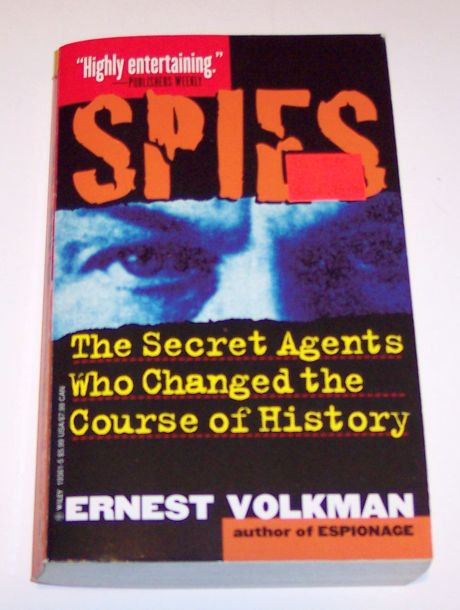
|
"Spies - The Secret Agents Who Changed the Course of History" (288 pages) - 1994. |
Written by Ernest Volkman and published by Wiley. Includes a section titled "Igor Gouzenko: The First Man" which is about 10 pages long. Here are the first words: "Igor Gouzenko - The First Man" Code Names: Corby, Klark / Alias: Richard Brown / 1919-1982. The 26-year-old Russian, newly arrived in Canada, had never seen anything like it. He cut the small story out of the local Ottawa newspaper and showed the clipping to all his co-workers. Was this not, he asked them, the most incredible thing they had seen? The story, reporting a routine enough occurence in the city of Ottawa, concerned a Greek fruit merchant who was suing the city for constructing a road in such a way that it was destroying his business. Igor Gouzenko read the story repeatedly, and the more he read, the more astonished he became. For a faithful Soviet apparatchik, the idea that an ordinary citizen could actually sue the government was almost beyond belief. The fruit merchant episode was the first of several lessons on life in the West that caused a profound change in Gouzenko. The contrast between the standard of living of the average citizen in Canada and the grim, grinding poverty of a Soviet citizen could not have been greater. And as Gouzenko saw more aspects of life in the West, he became steadily more disillusioned about the Soviet system. |
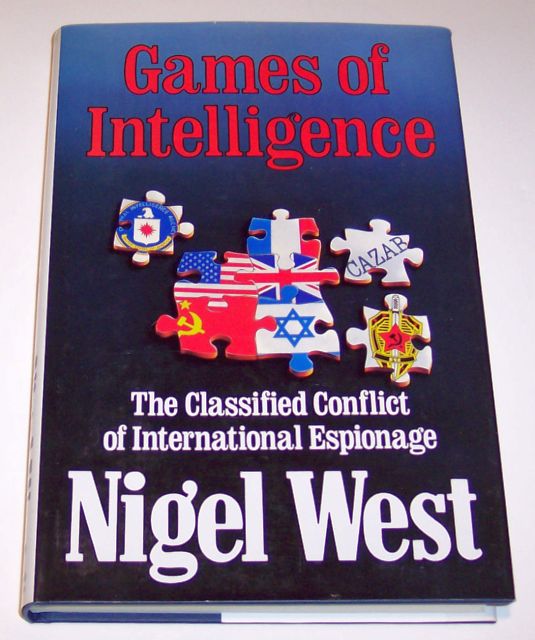
|
"Games of Intelligence - The Classified Conflict of International Espionage" (248 pages) - 1989. |
Written by Nigel West and published by Weidenfeld & Nicolson. Here is an excerpt: "The single individual who did more to alert the West to the Soviet post-war espionage threat was, ironically, a member of the GRU. Igor Gouzenko defected from the Soviet embassy in Ottawa in September 1945, bringing with him a stack of 109 documents purloined from his coderoom. Gouzenko's haul revealed some of the operations of a sophisticated GRU network based in Canada, with links further afield, but he was unable to shed much light on another group active in the same field known as the Smezhniki, or `the Neigbours'. Gouzenko's office was in a special suite of eight offices on the second floor of the embassy, at 285 Charlotte Street, and extraordinary precautions had been taken to seal off this particular wing from the rest of the building. A pair of huge steel doors guarded the entrance, and none of the GRU personnel was permitted to trespass into the NKVD's special rooms which were barred and shuttered. The Neighbours even boasted their own separate cipher arrangements and an incinerator to destroy secret communications. The GRU's parallel organization was the NKVD, headed in Ottawa by Vitali G. Pavlov, whose official status was a diplomat with the rank of a second secretary. Although Gouzenko could testify to the integrity of the security precautions taken by the Neighbours, he was unable to expose the organization's operations. Nevertheless, he did shed considerable light on the GRU's activities, and a number of networks were rolled up by the Royal Canadian Mounted Police's Special Branch and Britain's Security Service in consequence, including twenty Canadian Communists, of whom eleven were imprisoned. Similarly, Kirril M. Alexeev, the commercial attaché in Mexico who defected the following year, was able to identify Lev A. Tarasov as the local NKVD Rezident, but could not do much more in terms of naming individual agents." |
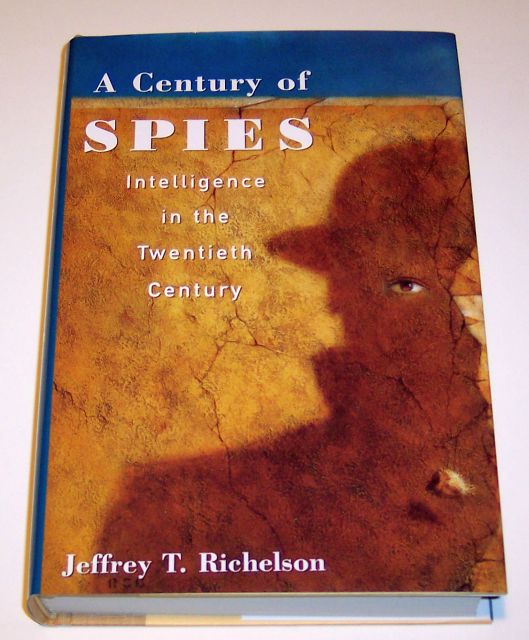
|
"A Century of Spies - Intelligence in the Twentieth Century" (534 pages) - 1995. |
Written by Jeffrey T. Richelson and published by Oxford. Here is an excerpt: VENONA "It was not long after the UKUSA agreement was signed that the American and British codebreakers were able to jointly exploit Soviet communications that had been intercepted in 1944 and 1945. The ability to break into those communications was one of several postwar events that resulted in significant setbacks to Soviet intelligence operations. On September 5, 1945, Igor Gouzenko, a GRU code clerk at the Soviet embassy in Ottawa, stuffed more than 100 documents under his shirt - including pages from the diary of the GRU resident. Gouzenko succeeded in defecting and obtaining protection from Canadian authorities, although not easily. When the police began translating Gouzenko's documents and interviewing him they discovered a major Soviet espionage effort in Canada - an effort which penetrated the Department of External Affairs cipher room, the Royal Canadian Air Force intelligence department, Parliament, the National Research Council, the Department of Munitions and Supply, and, in the person of Allan Nunn May, Canada's atomic research laboratories. The Soviets had acquired engineering blueprints of weapons, as well as samples of enriched uranium-535. Gouzenko's documents and debriefings also revealed intelligence on Soviet cipher systems, evidence of espionage by Alger Hiss and U.S. Treasury official Harry Dexter White, and the existence of a Soviet spy in British intelligence code-named ELLI." |
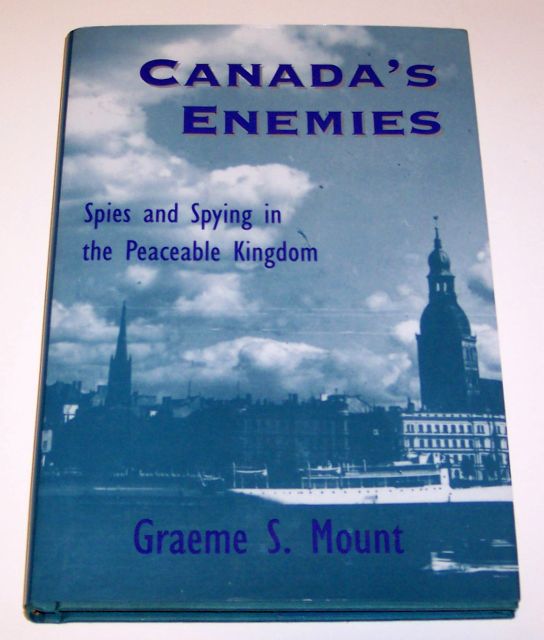
|
"Canada's Enemies - Spies and Spying in the Peaceful Kingdom" (158 pages) - 1993. | Written by Graeme S. Mount and published by Dundurn. Here is an excerpt: "... When Soviet cipher clerk Igor Gouzenko defected from his legation in September 1945 with extensive documentation on an international spy ring, the Canadian government did not know what to do and to seek advice from the British and Americans. ... Were there other spies to replace those exposed and arrested in the aftermath of the Gouzenko disclosures, or did Gouzenko place roadblocks at the end of many trails? ... |
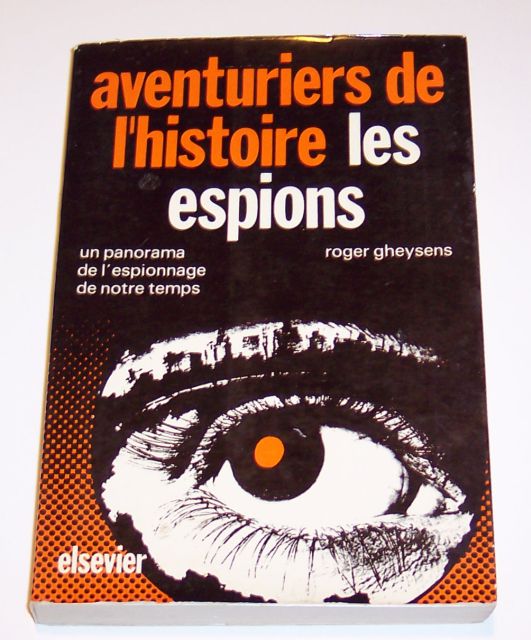
|
"Aventuriers de l'histoire - les espions" (315 pages) - 1973. | Written by Roger Gheysens and published by Elsevier. Here are some excerpts: "Le vaste réseau soviétique de vols de secrets atomiques qui se développa en Amérique du Nord au cours de la Seconde Guerre mondiale et découvert en mai 1945 grâce à la défection d'Igor Gouzenko, était dirigé, du Canada, par le colonel Nikolaï Zabotine, attaché militaire à Ottawa. Depuis mai 1943, le savant anglais Allan Nunn May, physicien nucléaire, transmettait ses informations directement au lieutenant Angelov, adjoint du colonel Zabotine, à qui il fit également parvenir en juillet 1945 de microscopiques échantillons d'uranium, U 235 et U 233, soustraits au laboratoire où il travaillait. ... Après sa défection à Ottawa, le 5 septembre 1945, Igor Gouzenko avait également déclaré qu'il était écoeuré de voir l'Union Soviétique se livrer à un effort massif d'espionnage au détriment de ses alliés, l'Angleterre, le Canada et les Etats-Unis. ... L'un des premiers transfuges d'après la Seconde Guerre mondiale fut Igor Gouzenko, employé au Chiffre de l'ambassade soviétique à Ottawa. Arrivé en 1943 au Canada, à l'âge de vingt-quatre ans, avc sa femme et son bébé, Gouzenko est séduit par la vie nouvelle qu'il y découvre et décide le 5 septembre 1945 de « choisir la liberté ». A ce moment, Ottawa est devenue le « point central » où sont rassemblées les plus importantes informations sur les activités des espions soviétiques. Les cryptanalistes du F.B.I. et de la C.I.A. surveillent de très près, en effet, l'ambassade soviétique de Washington et le sécrétariat de l'O.N.U. Pour rallier l'Ouest, Gouzenko vole des documents dans les chambres fortes de son ambassade et se présente dans plusieurs grands journaux d'Ottawa ... où personne ne veut croire sa rocambolesque histoire! Insuccès aussi au ministère de la Justice, puis au ministère des Affaires étrangères où on lui conseille ... de rejoindre son ambassade! Désappointé et déconcerté, Gouzenko rejoint son domicile. Mais, à l'ambassade, on a constaté la disparition des dossiers et Gouzenko voit arriver chez lui des agents soviétiques. Affolé, il se réfugie chez un voisin de palier avec sa femme et son enfant. Ce voisin, moins incrédule que les journalistes, prévient la police canadienne: celle-ci surprend, la même nuit, des membres de l'embassade soviétique qui, après avoir fracturé la porte de l'appartement de Gouzenko, mettent les lieux à sac dans l'espoir de recouvrer les dossiers secrets. Cette fois, les autorités canadiennes sont bien oubligées de croire Gouzenko, elles lui accordent le droit d'asile et le mettent au secret, avec ses documents. On se demande quelle a dû être la réaction des journalistes d'Ottawa quand ils apprirent combien ils étaient passés « à côté de la montre en or »! Dans les dossiers, contenant plus de cent documents, livrés par Gouzenko, figurait entre autres tout l'organigramme de l'espionnage soviétique en Amérique du Nord, réseau fonctionnant depuis 1942, date de l'ouverture des relations diplomatiques entre l'U.R.S.S. et le Canada et permettant la transmission à Moscou d'importants secrets militaires. Le F.B.I. eut tôt fait de remonter les filières. A plus ou moins long terme, la défection de Gouzenko permit l'arrestation en 1946 du savant atomiste anglais, le Dr Alan Nunn May, et celle en 1950 du Dr Klaus Fuchs, grand responsable de la « fuite atomique », celle aussi de Harry Gold, un des principaux courriers du réseau, de David Greenglass, et enfin la capture des époux Julius et Ethel Rosenberg qui seront exécutés le 19 juin 1953. Car les Américains avaient réagi brutalement aux révélations de Gouzenko et, le 1er août 1946, le Congrès avait voté la loi MacMahon entourant d'un secret absolu toutes les fabrications militaires, toute rupture de ce secret pouvant entraîner la peine de mort." |
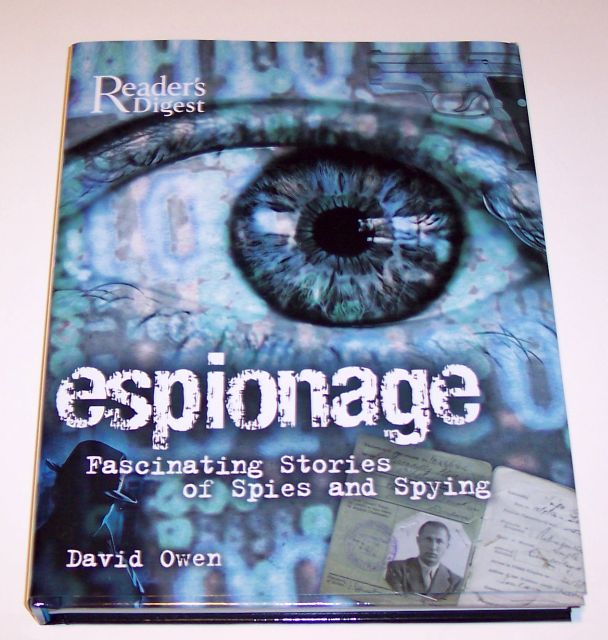
|
"Espionage - Fascinating Stories of Spies and Spying" (176 pages) - 2006. |
Written by David Owen and published by Reader's Digest. Here is an excerpt: "Meanwhile, Russian agent Igor Gouzenko, who defected in Ottawa in September 1945, identified a British scientist inside the atomic bomb program as a former member of the Communist party and a Soviet spy. Dr. Alan Nunn May had worked in Montreal, and Gouzenko knew the scientist had sent the Russians small samples of the uranium used for the bombs. He had returned to his work in Britain, but the Canadians informed the British of his treachery, and he was promptly arrested. He claimed at his trial that when he passed the information along, Russia had been allied with Britain and the United States, and that he was acting for the overall safety of mankind, but the court refused to accept his defense. He was given a ten-year jail term. This was the tip of the iceberg. Gouzenko knew there were more Soviet spies with access to the secrets of the atomic bomb project, but they appeared in his records only as code names. The code was eventually cracked when Soviet diplomatic radio signals were deciphered under the Venona program." |
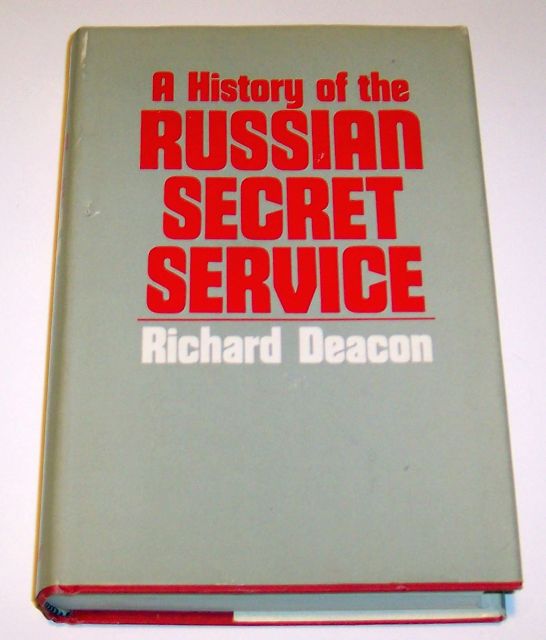
|
"A History of the Russian Secret Service" (568 pages) - 1972. |
Written by Richard Deacon and published by Taplinger. Here are a few excerpts: "Enough damage had already been done to enable Russia to get back into the race for atomic supremacy, and the effects might have been even worse but for the surprise defection of Igor Gouzenko, a cipher clerk in the Soviet Embassy in Ottawa. The story of Gouzenko is well enough known, but it provides an example of the gravest danger which must always confront Russian Intelligence as long as the Soviet Union remains a totalitarian, police state. A trusted servant of the Soviet state is sent abroad, he contrasts the freedom and luxuries of the democracies with life at home and he suddenly wishes to opt out of the horrors of Communist tyranny. So it was with Gouzenko. But he knew, as others since him have learned, that would not be given adequate protection against Soviet revenge unless he came across with worthwhile information. Gouzenko did just that: he went to the Canadian Mounted Police and handed over documents which showed beyond question the extent of Soviet espionage in Canada. The Russians indignantly insisted that Gouzenko was a thief who had stolen documents and money from the Soviet Embassy and demanded that he be handed back to them. The Canadian authorities refused, though at one time there was a real risk that they did not realise the seriousness of the situation and Gouzenko was nearly returned to his embassy." |
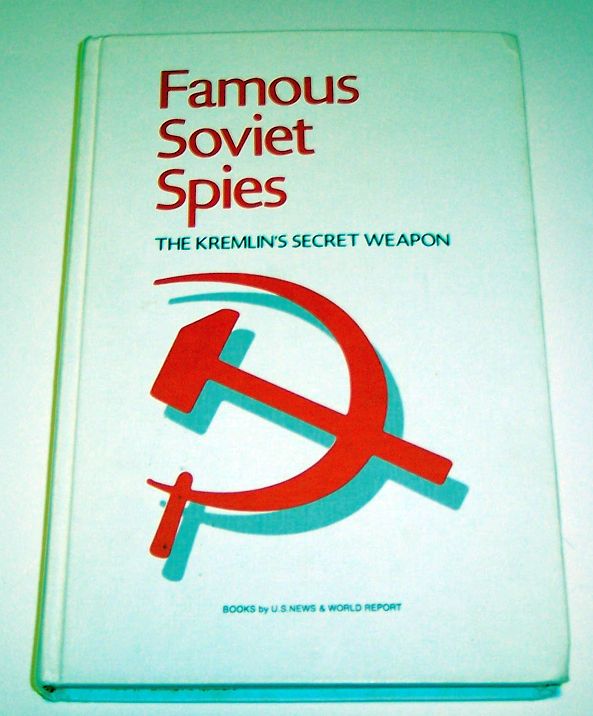
|
"Famous Soviet Spies - The Kremlin's Secret Weapon" (223 pages) - 1973. |
Book by U.S. News and World Report with Joseph Newman as Directing Editor. Chapter Three is titled "Igor Gouzenko - The Spy They Wouldn't Listen To". A few paragraphs: The exposure of these spy rings - three in the United States, several in Great Britain, and one in Canada - came not only through the efforts of Allied Counterintelligence and the FBI after 1946, but also through the revelations of one man - Igor Gouzenko. He was, until his defection, a Soviet spy. Having had the opportunity to compare the Soviet Union with the West, Gouzenko made his choice. He did so at the risk of his life. In the dusk of the unseasonably hot September evening, Igor Gouzenko made his solitary way from his residence at 511 Somerset Street toward his place of business on Range Road in the city of Ottawa, Canada. He had gone through the motions of eating an early dinner. Then had said good-by to Anna, his wife, and Andrei, his two-year old son. he did not know whether he would be returning to them, and if he did, into what kind of peril he might be plunging them. He knew only that he had crossed his Rubicon. Anna, from whom he drew strength, supported his decision. She was nearly six months pregnant, and he must act now while was stil able to move with reasonable speed. Ostensibly, Gouzenko worked in Canada as a secretary and interpreter attached to Colonel Nikolai Zabotin, the military attaché at the Soviet Embassy. Actually, however, he was one of a number of such officers at the embassy whose identity and purpose was concealed under the cover of a diplomatic cloak. Gouzenko's real job was to encode and decode secret messages sent to and from the Moscow Center; he was a cipher clerk. A lieutenant in the GRU, he served as a member of an extremely successful spy ring, directed by Colonel Zabotin. Gouzenko's faithful decision had been formulated a year ago on another September night when, after wandering the streets in the rain, he had returned home to tell his wife that word had arrived from Moscow for his recall. For the first time since their arrival in Canada, they had blurted out their mutual feelings. They wanted to stay! They wanted a new life in a free land for Andrei and themselves. To go back to what they had left was unthinkable. But how could they remain? At that time, in order to delay his recall, Gouzenko had suggested to Colonel Zabotin that because of his skill in English, he might continue to be of service, Surprisingly, Moscow had agreed, and during the twelve-month reprieve, Gouzenko had wrestled with the problem of devising a course of action that could make his stay permanent. This had been no easy thing to do, for life within the closed embassy community was a constant exercise in poker playing in which everyone watched everyone else. The Secret Police agent in the embassy was Vitali Pavlov, the second secretary. He was also the NKVD chief for Canada. Pavlov ran his own spy ring, staffed by embassy personnel. The NKVD cipher clerk, Farafontov, was listed as an embassy chauffeur. To Gouzenko's knowledge, nineteen members of the embassy staff were agents either of the GRU or the NKVD. Their primary mission was to steal all secrets of military, political, and economic significance that they could lay their hands on and transmit them to Moscow. |
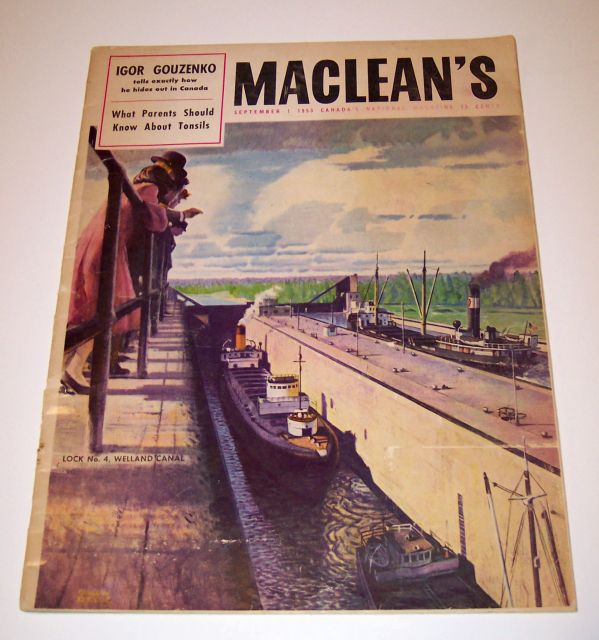
|
"Maclean's Magazine" - September 1953. |
An article featuring an interview with Igor Gouzenko. Its caption reads "Blair Fraser keeps a rendez-vous with Igor Gouzenko - Maclean's Ottawa editor meets the Russian Embassy clerk who broke a spy ring and has since hidden out under assumed names that only the RCMP knows. While keeping one jump ahead of Kremlin vengance he has written a novel that may bolster his sagging fortunes". At the bottom of the first page (click page 9 below), we read at the bottom - "One reward to Gouzenko for revealing the atom-bomb spy ring was Canadian citizen No 36,000. At right: first pictures of Gouzenko's secret hobby - a portrait of Inspector Herbert Spanton and a water color of an ornate Russian building." Here are the other pages of the article: |
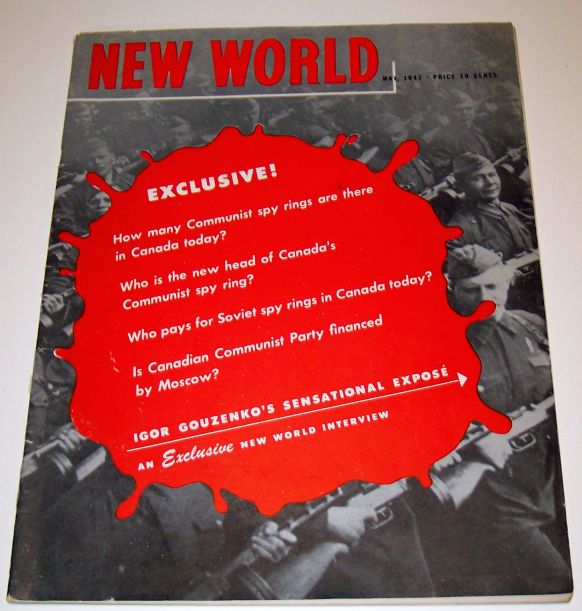
|
"New World Magazine" - May 1947. |
A rather interesting article on Communist spying in Canada following the Gouzenko affair. On the cover, it features the following topics:
Answer by Igor Gouzenko: "Yes. From 1929 the Soviet Government has energetically studied and fortified the Soviet Arctic. It has created on the Arctic Ocean big population centres. Some of them such as Igarka, Nordvik, Anadyr, Magadam, reach the size of big cities with populations up to 500,000 and even 1,000,000 inhabitants who are mostly political prisoners. Russia has built barracks, airfields, ports and weather stations in the Arctic, using political prisoners living in concentration camps to do the work. Under the conditions of tension in the international situation, Canada's desire to fortify the Arctic in co-operation with the United States is fully justified." Here are scans of some of the pages in the article including photos of material taken out by Igor Gouzenko upon his defection (with English summaries boxed within): |
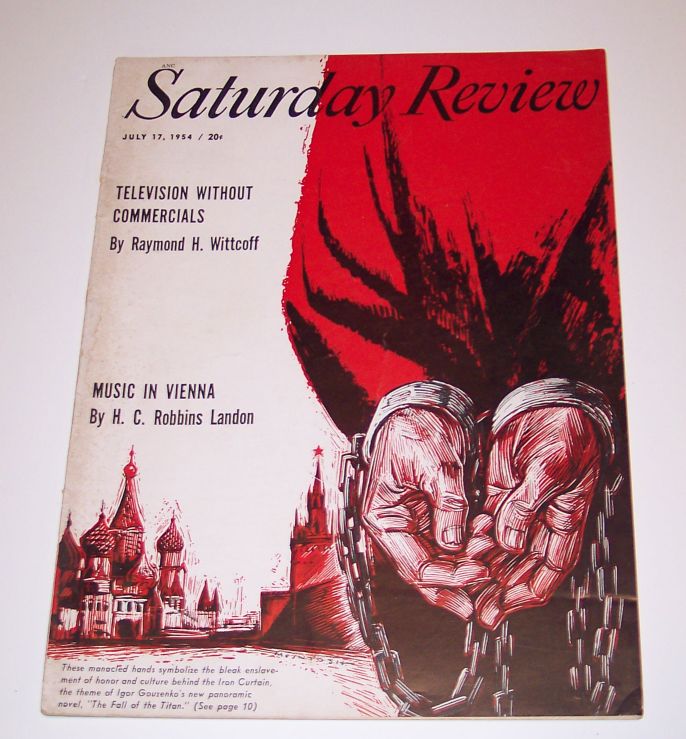
|
"Saturday Review" (Article on "Fall of a Titan") - July 17, 1954. |
Magazine article on the new release of Igor Gouzenko's new book "The Fall of a Titan". The cover of the magazine has a photo in which the manacled hands symbolize the bleak enslavement of honor and culture behind the Iron Curtain, the theme of Igor Gouzenko's new panoramic novel, "The Fall of a Titan". Here is a scan of the page (10) featuring the article. There is also a column on the author Igor Gouzenko written by Bernard Kale: The Author Igor Gouzenko began his career as a front-page disgrace to the Kremlin in September 1945, only a month after Hiroshima. Gouzenko, a twenty-six-year-old graduate of Moscow's Military Intelligence School, had spent two years as a code clerk in the Soviet Embassy in Ottawa when he decided to walk out on the USSR with 109 documents stuffed under his shirt. Unwrapped, these reports and memorandums represented the first pieces of evidence of a Soviet atom spy ring in North America. They disclosed that Dr. Allan Nunn May, a physicist whose subsequent conviction led to Fuchs and the Rosenbergs, had tipped off the Russians about our A-bomb experiments and had even passed along a sample or two of uranium. As for Gouzenko, he, his wife and their two children were promptly absorbed into Canada's day-to-day life under assumed names (his boy and girl don't even know they are little Gouzenkos). Someone from the Royal Canadian Mounted Police is always within shouting distance, just in case. In his disguise, as just another Iron Curtain refugee, Gouzenko became a writer and, "somewhere in Canada" the other day, he discussed how he'd gone from dabbling in short stories in his youth to "The Fall of a Titan". "When I was a pupil in Russia I wrote good compositions," he began proudly. "one about a boy becoming a famous violinist was particularly praised by my teachers. I was then in the fifth grade, about eleven years old." His memoirs, "The Iron Curtain", followed in 1948 when he was about twenty-nine. He spent four years on "The Titan" - one looking for a subject, three in the writing. It was turned down by a half-dozen American publishers before Norton accepted it last fall, unaware that Igor Gouzenko was the Igor Gouzenko. Not long afterwards the Jenner Committee went to Canada to discuss the espionage business with Gouzenko, and his picture appeared in the front pages. His head was in a hood. |
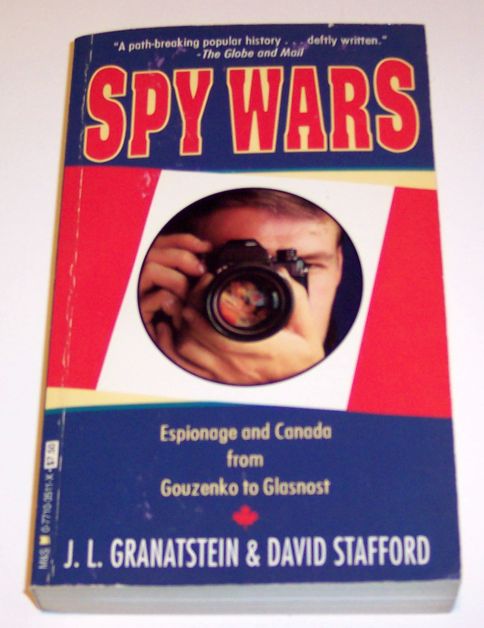
|
"Spy Wars - Espionage and Canada from Gouzenko to Glasnost" (276 pages) - 1990. |
Written by J.L. Granatstein and David Stafford. Chapter 3 covers "The Man who Started the Cold War". |
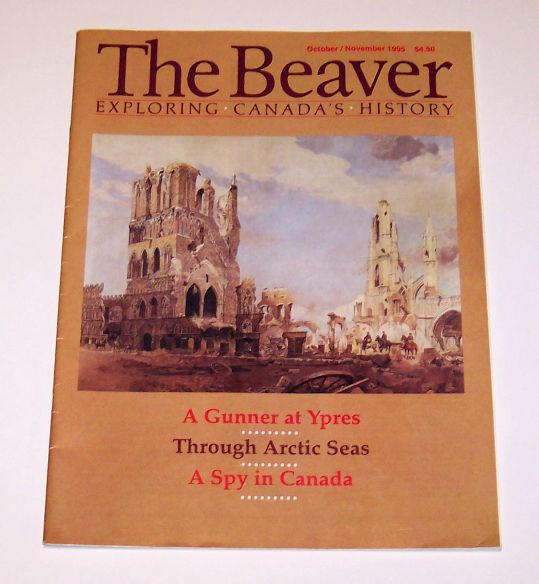
|
"Igor Gouzenko and Canada's Cold War" (5-page article) - October/November 1995 Issue of "The Beaver". | Article written by Laurence Hannant. First paragraph: Fifty years ago Canada was thrown into the menacing shadows of international espionage when a cipher clerk in the Soviet embassy in Ottawa stuffed 109 documents into his shirt and fled into a humid late summer night seeking asylum. With the defection of Igor Gouzenko the Cold War was born, less than a month after the close of the Second World War. Here are photos of the respective pages in this article: |
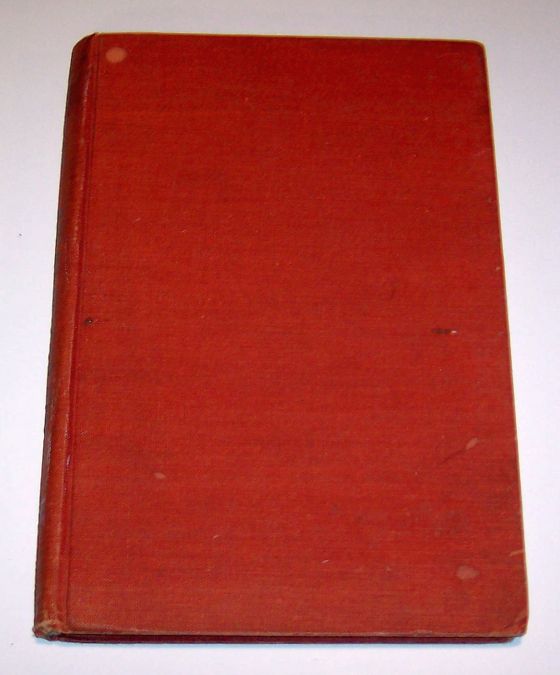
|
"The Soviet Spies - The Story of Russian Espionage in North America" (164 pages) - 1948. | Written by Richard Hirsch and published by Nicholas Kaye. Here is a photo of the title page. As part of the Foreword, we have: It was Igor Sergeievitch Gouzenko who revealed the existence of a widespread conspiracy to obtain secret official information respecting the military potential of Canada, the United Kingdom, and the United States, and to convey such information to the government of the U.S.S.R. At eight o'clock on the evening of September 5, 1945, he left the Soviet Embassy in Ottawa with one hundred documents belonging to the officially accredited Soviet diplomatic representatives. In so doing, he betrayed his government, his superiors, and his oath of office. As wards of the Canadian government, Gouzenko and his family are being accorded the close protection of the Royal Canadian Mounted Police. Gouzenko made possible the exposure of various persons who were enraged in betraying their oaths of office, their superiors, and the governments of Canada, the United Kingdom, and the United States. From the long-range viewpoint the significance of these multiple betrayals lies in the fact that they were from Communism to Democracy and from Democracy to Communism. Such actions establish a pattern which in the future may take place with increasing frequency. A unique reflection on sociological forces at work in the world todayis the ease with which Soviet representatives were able to persuade the self-admitted Communists and secret adherents of the Communist Party to sell out their country. |
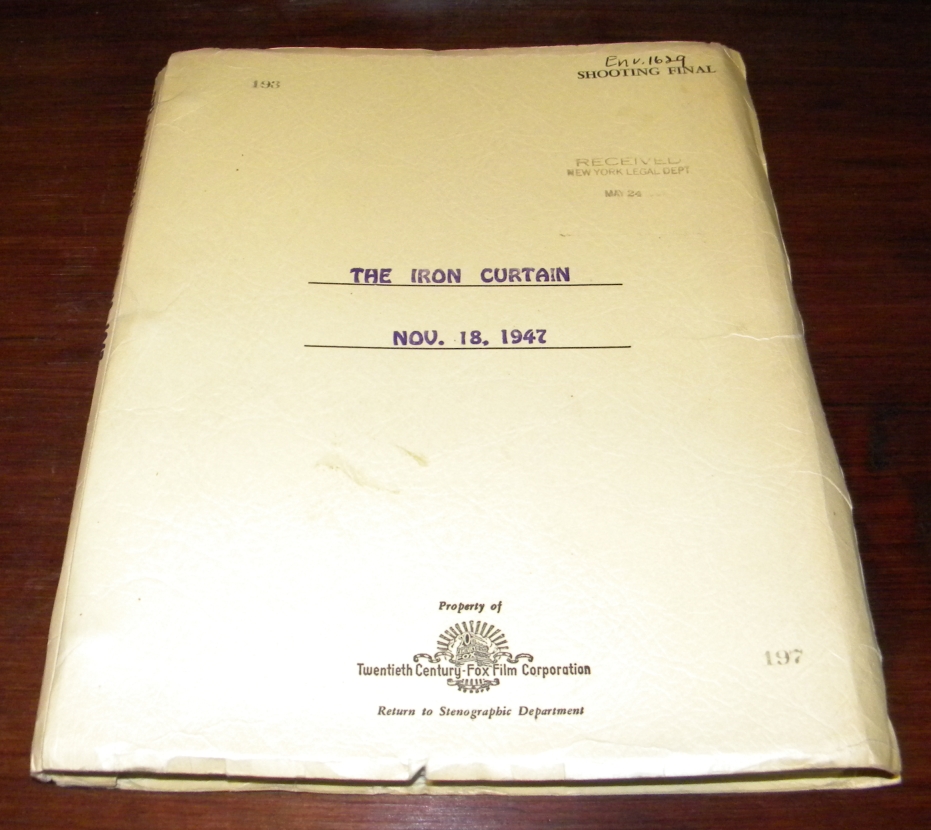
|
Script for "The Iron Curtain" - November 1947. | Original shooting final script for "The Iron Curtain" movie dated 18 November 1947. That movie was produced by 20th Century Fox in 1948. |
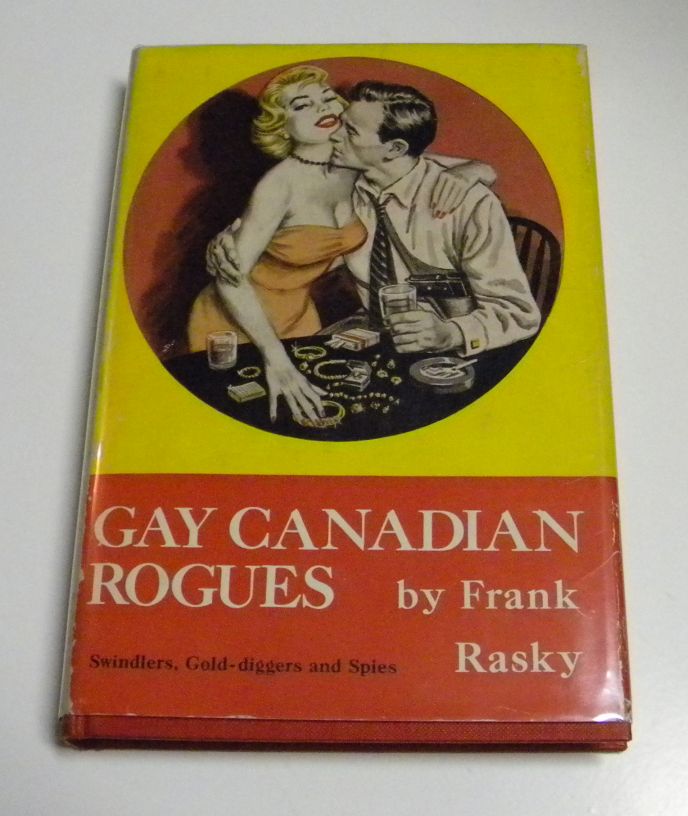
|
Book "Gay Canadian Rogues - Swindlers, Gold-diggers and Spies" written by Frank Rasky - 1958. | There are two chapters covering Igor Gouzenko:
|
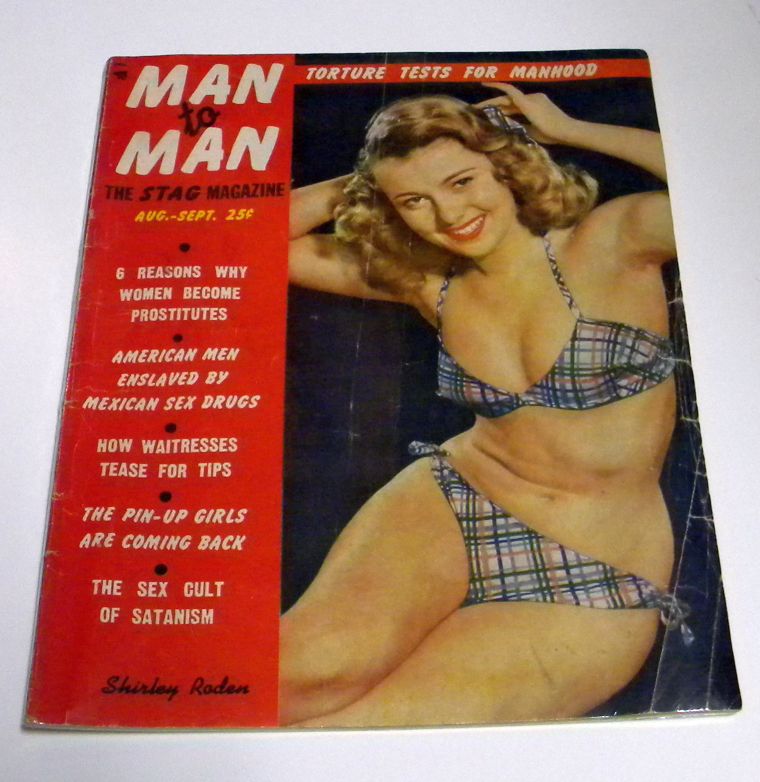
|
Magazine "Man to Man - The Stag Magazine" August-September Issue - 1951. |
This magazine includes an article titled "How We Caught the Atom Spies" by Edward R. Thompson (Special Agent, RCMP) "as told to Kurt Singer". The article is covered on pages 22-23 and 46-47. Here is a scan/photo of the first page of the article which includes a photo from the movie "The Iron Curtain" featuring Dana Andrews and Gene Tierney. Here is an excerpt from the article: ... It was September 1945 and still quite warm in Ottawa. All at once we in the political division of the police department were suddenly informed that a Russian code clerk had stolen a number of secret Soviet documents from the Russian Embassy in Ottawa and wanted to sell them to the newspapers. It also appeared that he had tried to see the Minister of Justice, but nobody in that department had dreamed that his documents might prove the existence of a dangerous spy ring. Now we, the special agents of the Royal Canadian Mounted Police, were being given top secret orders and warned that for some time to come we would not see our wives. We had to leave our offices in Ottawa and Montreal and report at Rockliffe Barracks. We did not know much about the undertaking assigned to us, but we were aware from the start of a great air of excitement surrounding it, and excitement that infected Prime Minister William Lym McKenzie King, army officers, representatives of the Department of Justice, and of course, our own Inspector John Leopold, head of the anti-espionage squad. The cause of all this excitement was 25-year old Igor Gouzenko, a code clerk who insisted with deadly seriousness that he would be killed by the NKVD (the secret Communist terror organization) if they could get their hands on him. The police had been instructed to look after his safety, and two of our very able agents had been following Gouzenko and his attractive wife and little baby. At this point the Russians did not know that the Gouzenko case was in our hands, nor did Prime Minister McKenzie King until a little later. McKenzie King, in fact, had asked his secretary to give a message to Gouzenko not to make trouble between Canada and the Soviet Union and to return all the papers he had taken to the Russian Embassy. The members of the Government had to weigh certain possibilities. Gouzenko might mentally unbalanced. He might be a crank. He might even be an agent provocateur. We special agents quickly knew better. We learned that the Soviet Embassy was calling for special action, and soon afterwards Soviet agents raided Gouzenko's home at 511 Somerset Street, Ottawa. ... What we had to start with were hundreds of documents in Russian. First of all, we got an expert Russian translator, a person we could trust, to translate these documents. They were full of technical terms, so we had to turn to scientists to explain to us the terms. Even then they were hard to understand. Meanwhile, Inspector Leopold was begging us to hurry our investigation, for it was Leopold's duty to brief Prime Minister McKenzie King on what was being turned up, and the Prime Minister in turn was informing the Canadian Government, the Government of Britain, and the United States Government. Finally, after much sifting of the documents and after interrogating Gouzenko day and night, we concluded that a Russian-Canadian-Communist spy ring with ramifications in the United States had been able to obtain information on matters that were most vital to the Western Hemisphere. In tabular form, these matters were:
And I knew that months if not years of hard work lay ahead for rounding up the Soviet gang engaged in a global hunt for atomic secrets. At last I came on one tiny hint. It was a coded cable that read: "Badeau asks for permission to change to work on Uranium." That was my first slight clue. Who was Badeau? And where was he? I was trying to guess and wondering about pumping Gouzenko when Inspector Leopold gave me these instructions: "Concentrate on one man only. One man alone: Alek. Alek is probably not in Canada. Comb the earth for him but find Alek. Read again all the Gouzenko documents. It is Alek I want." ... |
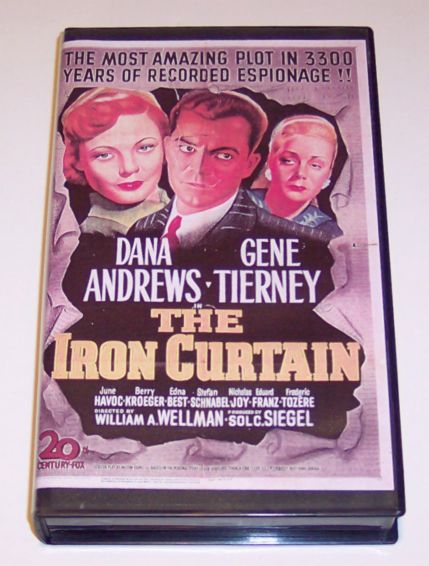
|
Movie "The Iron Curtain" (VHS B/W) - Originally aired in 1948. | Produced by 20th Century Fox in 1948. Dana Andrews and Gene Tierney starred - screenplay "based on the personal story of Igor Gouzenko former code clerk U.S.S.R. Embassy in Ottawa, Canada." Here are black and white photos of "The Iron Curtain" lobby cards from my collection: |
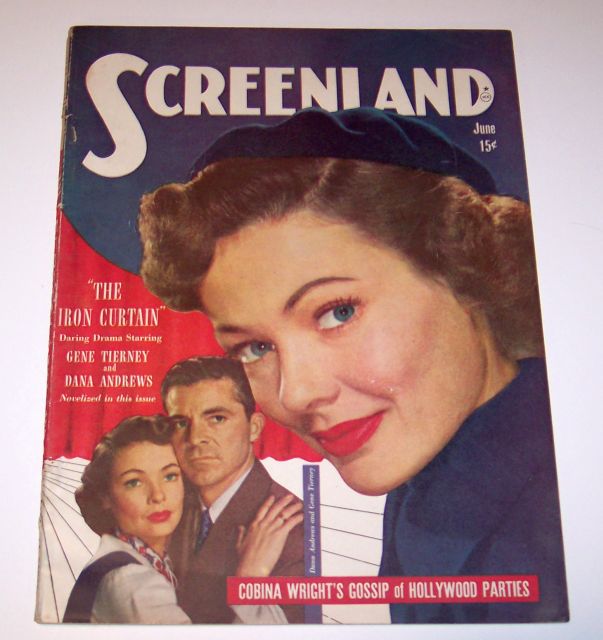
|
"Screenland Magazine" - June 1948. | A rather interesting article on "The Iron Curtain" movie. It features the following topics:
|
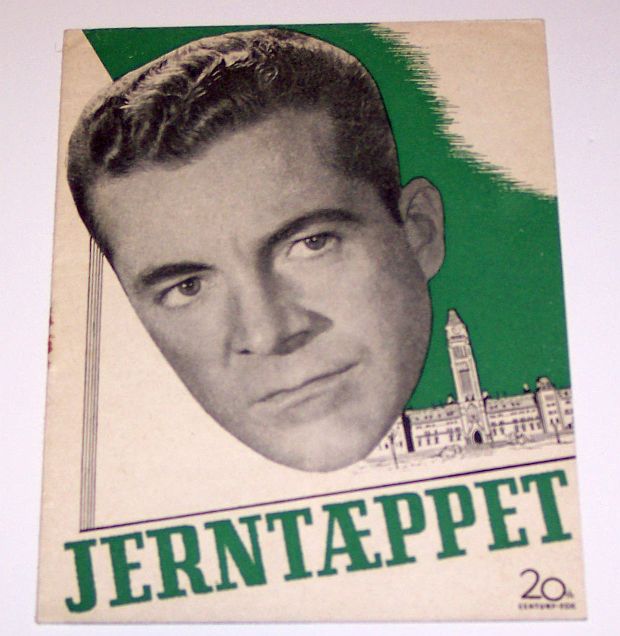
|
"The Iron Curtain" Movie Program - 1948. | Small movie program written in Dutch with Dana Andrews on cover and silhouette of Parliament Hill in Ottawa. |
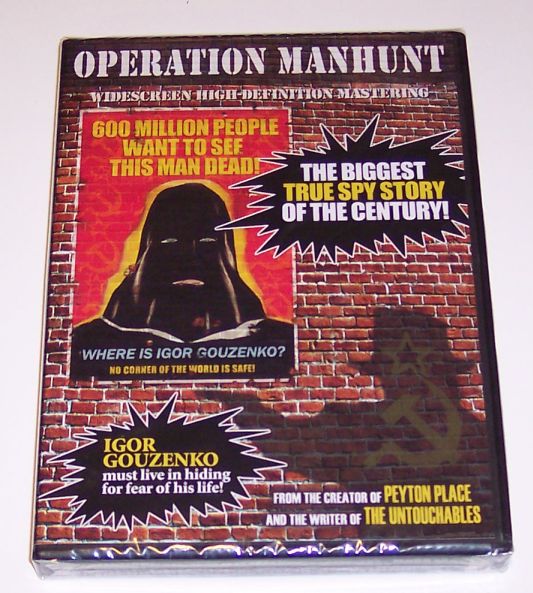
|
"Operation Manhunt" (78 minutes DVD) - Originally aired in 1954. | United Artists movie production in 1954. Caption included "This movie is the authentic, documented story of Igor Gouzenko, the former Russian code clerk whose sensational revelations smashed a giant Soviet espionage ring. Gouzenko, Target Number One on the Soviet Secret Service list, was forced to live in hiding, but secretly appeared in this feature film wearing a hood." Here are color photos of "Operation Manhunt" lobby cards from my collection:
|
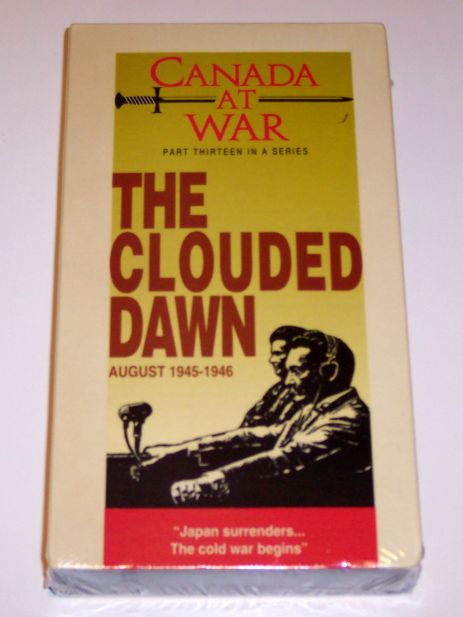
|
"The Clouded Dawn" (24 minutes VHS video) - 1962. | Video prepared by the National Film Board in Canada. Description details the following: "Japan surrenders, World War II is over, but the scars are deep. Canadian prisoners are released from Japanese war camps. In Canada as elsewhere, the monumental task of rehabilitation begins. In Ottawa, the Gouzenko case shocks the nation. The trials of Nuremberg begin. The United Nations is formed. Canada, now a much stronger independent nation, enters the Cold War." |
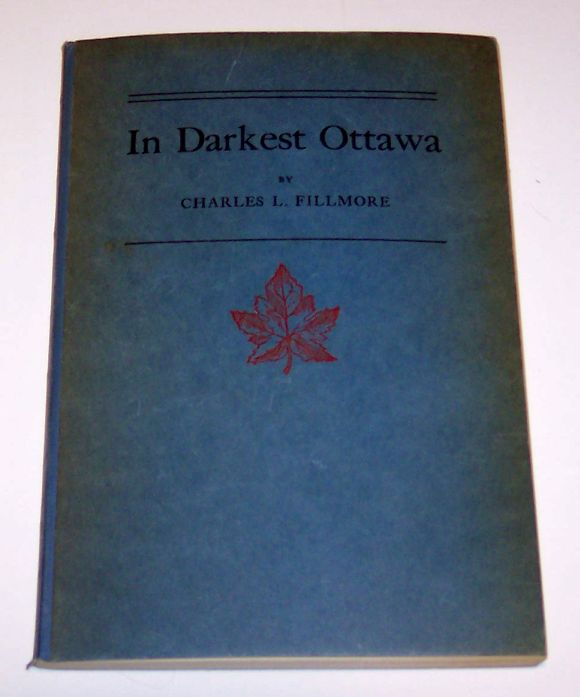
|
"In Darkest Ottawa" (49 pages)- 1954. | Written by Charles L. Fillmore and published by Rose, Cowan and Latta. First few paragraphs: In September 1945, one Gouzenko, employed in the Russian Embassy at Ottawa, determined he would not return to Russia though under orders from Moscow to do so. He wished to remain in Canada. On the 5th of September of that year he left the Embassy, taking with him his wife and child and certain documents to disclose to important Canadian authorities the work that was being carried on in Canada by Russian representatives. That work included the obtaining of material relating to the atom bomb, false passports, and most every secret Canada would not wish to part with, whether it benefited Russia or not. The night was spent by Gouzenko and his family in dodging strong-arm Russians. That night was drama, but could have been tragedy. The Canadian police took charge and Gouzenko and his family were saved. Consternation seized the Canadian authorities. The balance wheel at Ottawa flew to pieces, and what followed has seldom been equalled in fiction. |
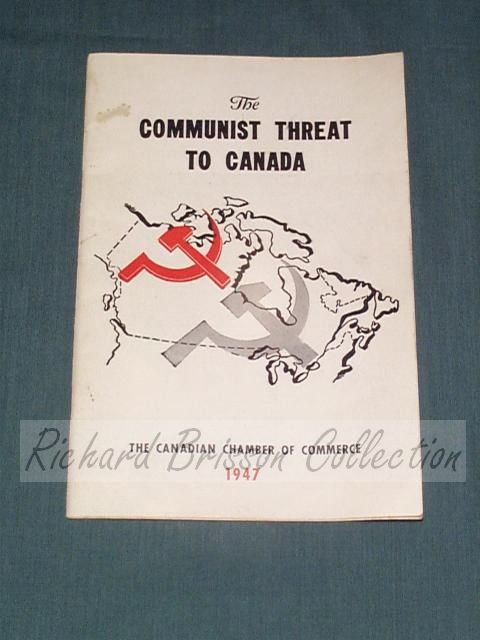
|
Booklet "The Communist Threat to Canada" - 1947. | Booklet produced by the Chamber of Commerce. It has a few entries on Igor Gouzenko: Igor Gouzenko was the cipher clerk of the Soviet Embassy at Ottawa, who in September, 1945, left the Embassy with certain documents which, combined with his testimony, proved invaluable to the Royal Commission on Espionage. In his statement on October 10th, 1945, Gouzenko said: The announcement of the dissolution of the Comintern was probably the greatest farce of the Communists in recent years. Only the name was liquidated, with the object of reassuring public opinion in the democratic countries. Actually the Comintern exists and continues its work .... The documents which Gouzenko brought with him corroborate this testimony. The importance of the Report of the Royal Commission cannot be overestimated. Despite the attempts which are still being made to discredit Gouzenko and his testimony it must be remembered that no attempt has been made to dispute the authenticity of the supporting documents which he produced as evidence. |
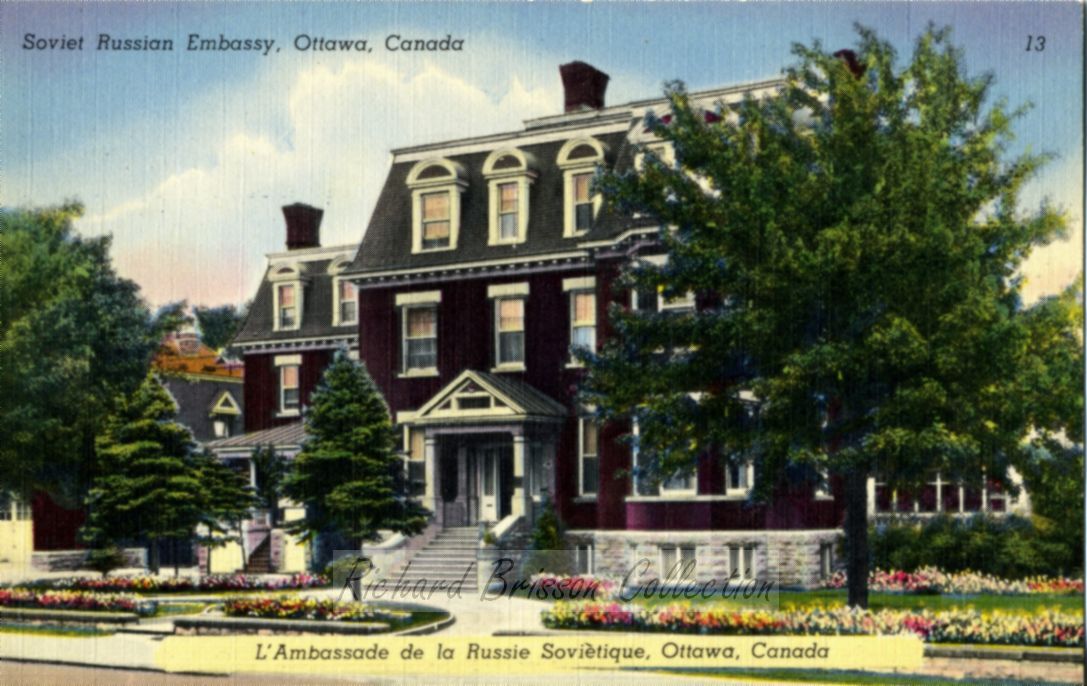
|
Postcard with Soviet Embassy on Charlotte Street in Ottawa - circa early 1950's. | Photograph of the Soviet Embassy on Charlotte Street before it burnt down on January 1st 1956. |